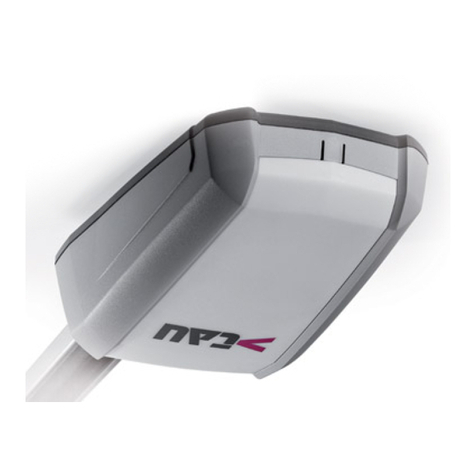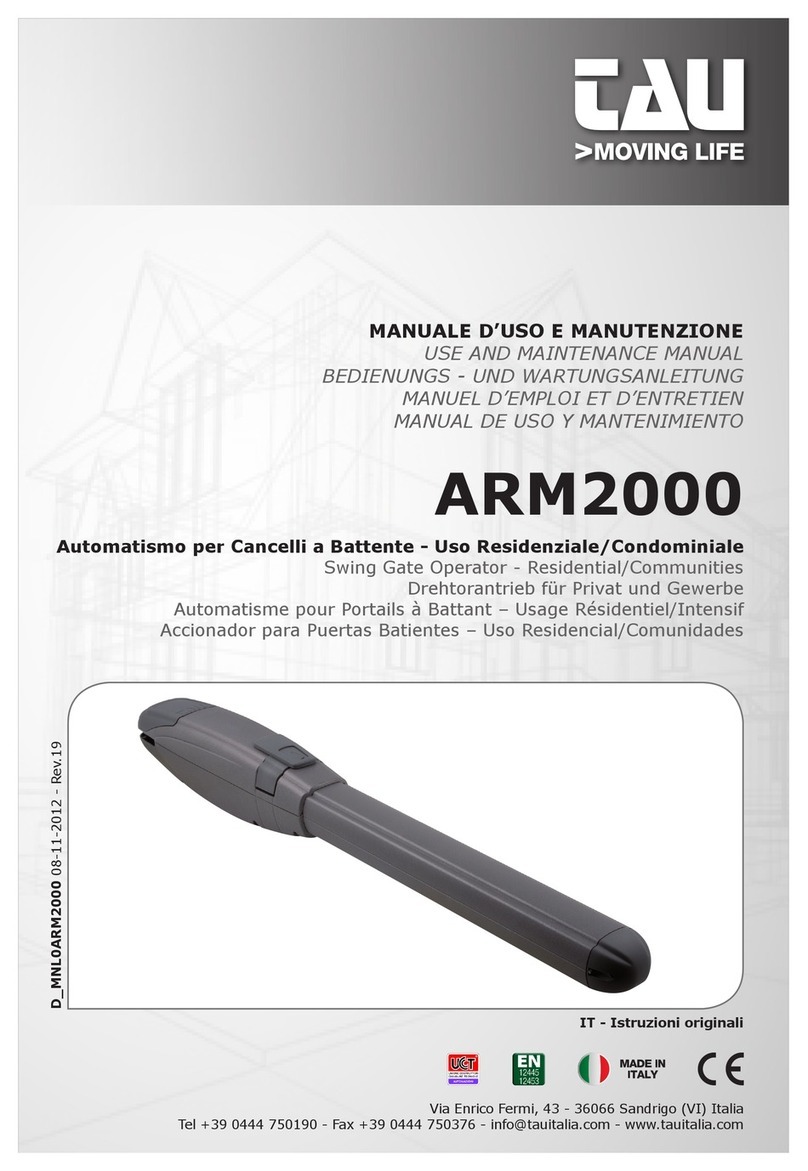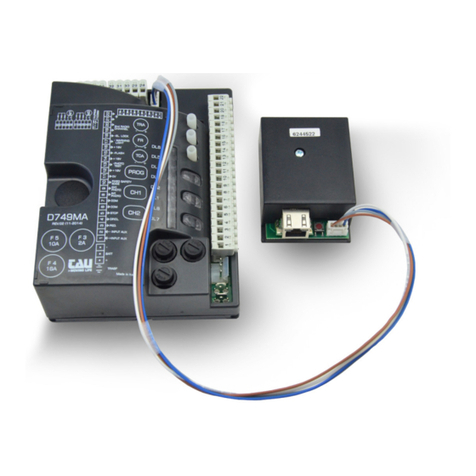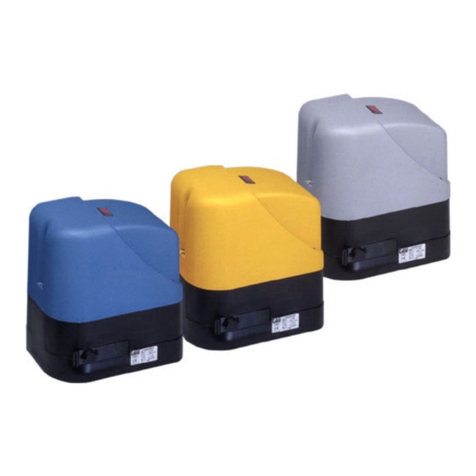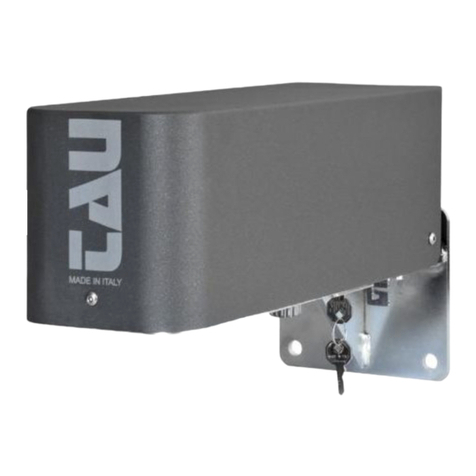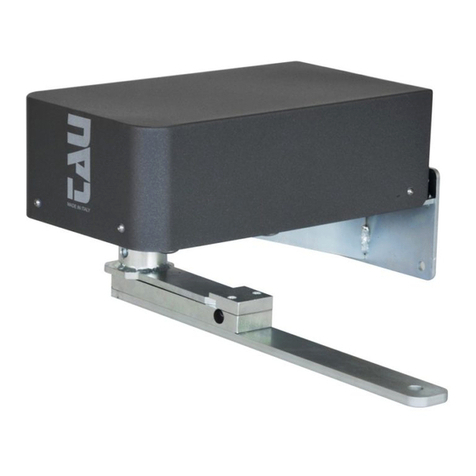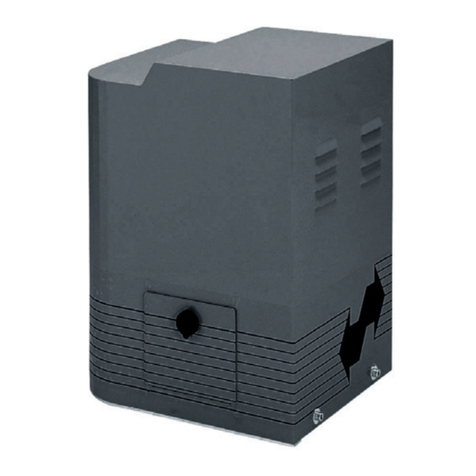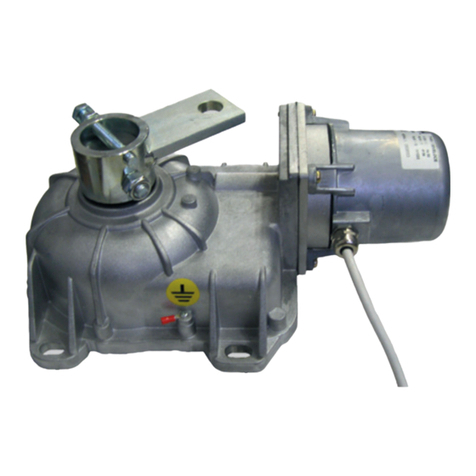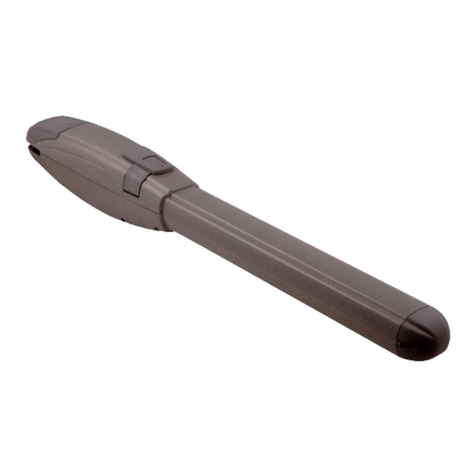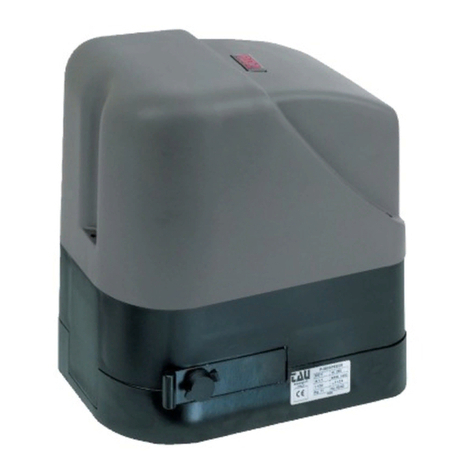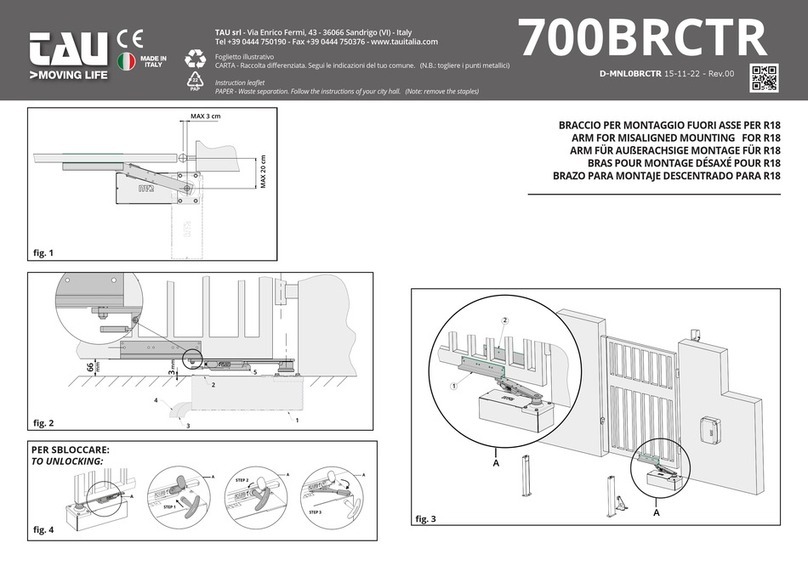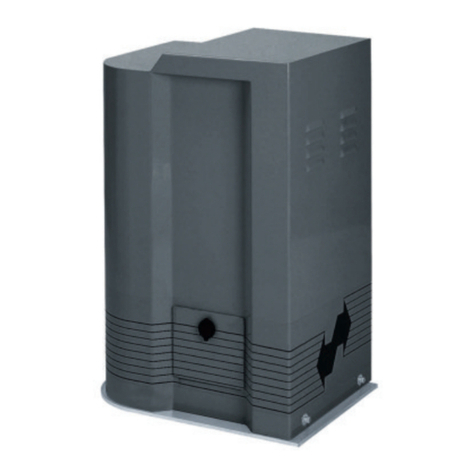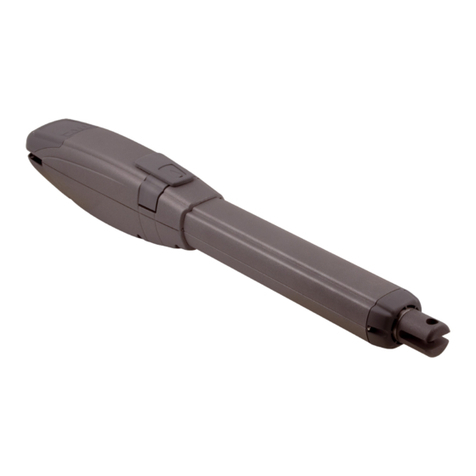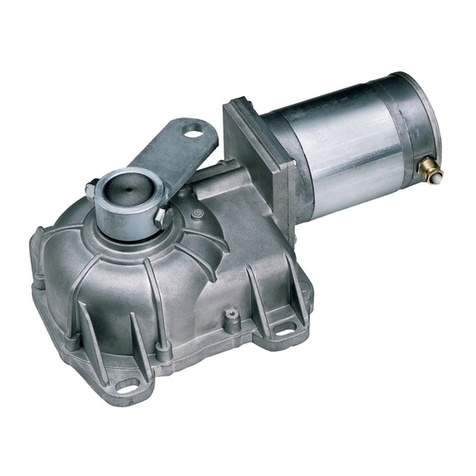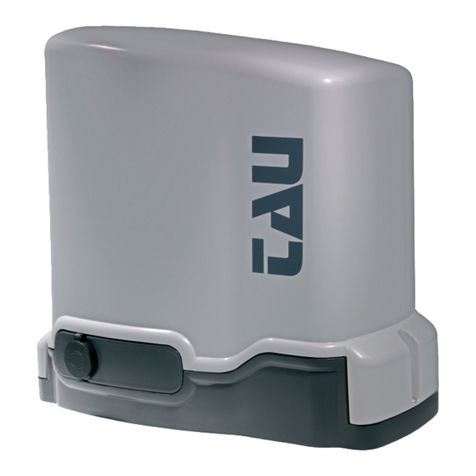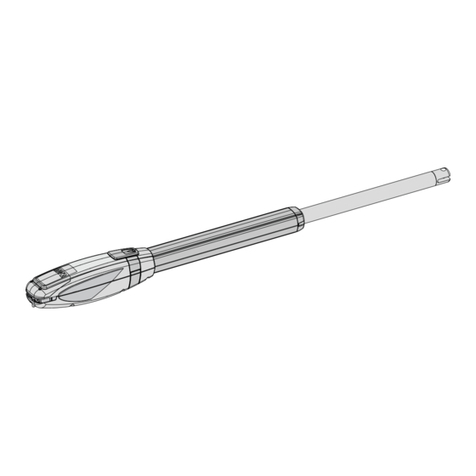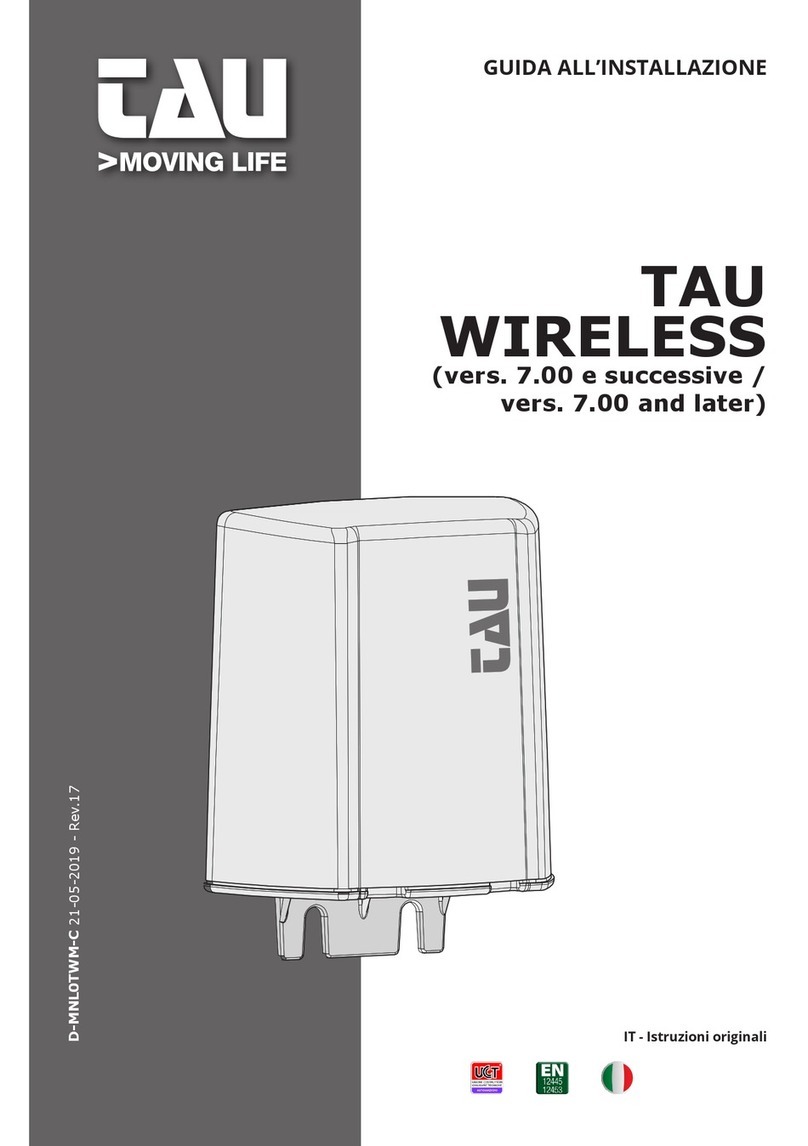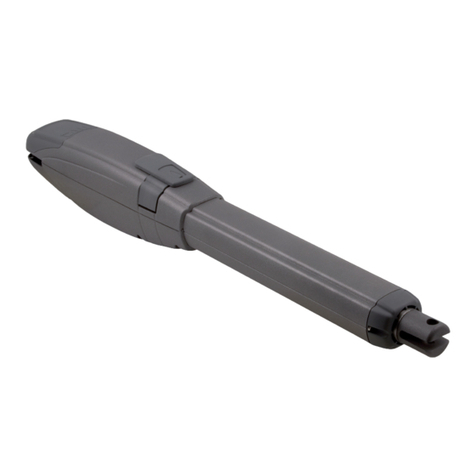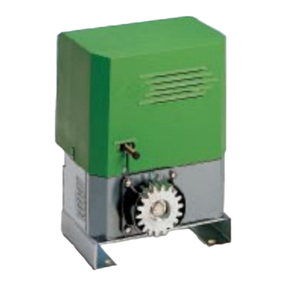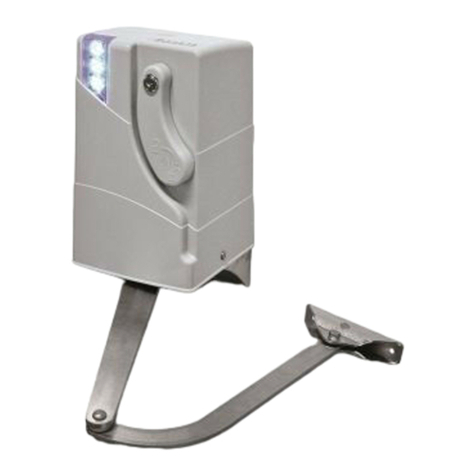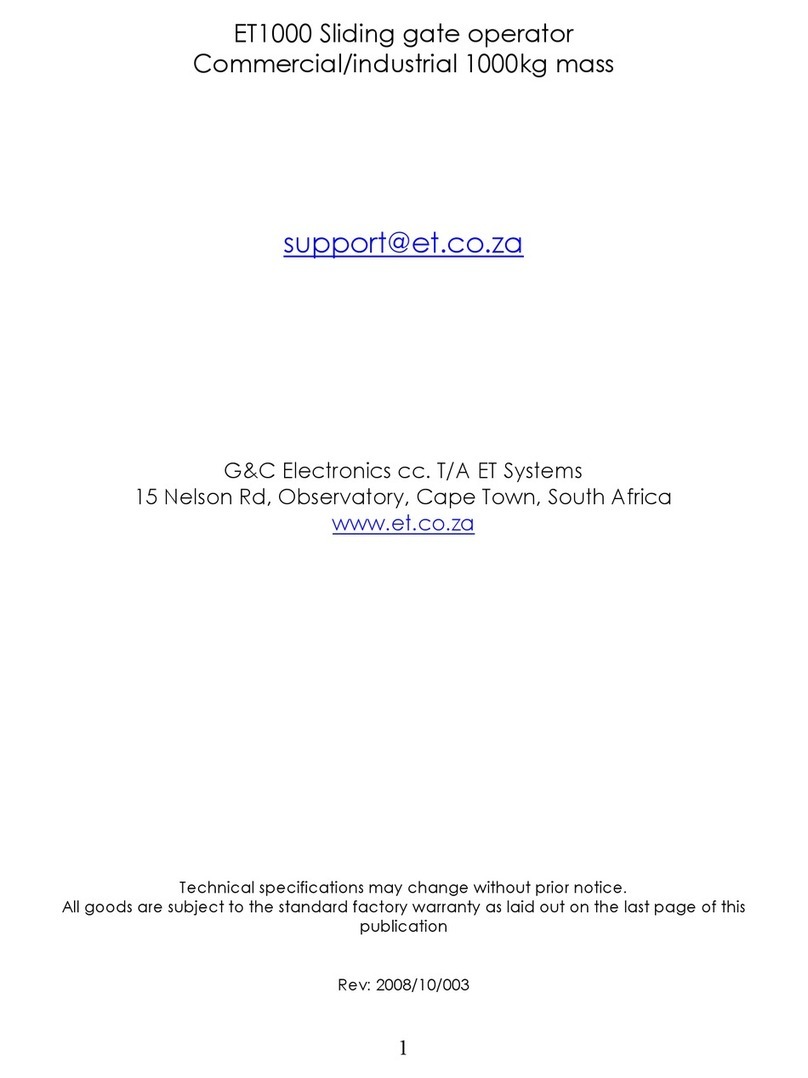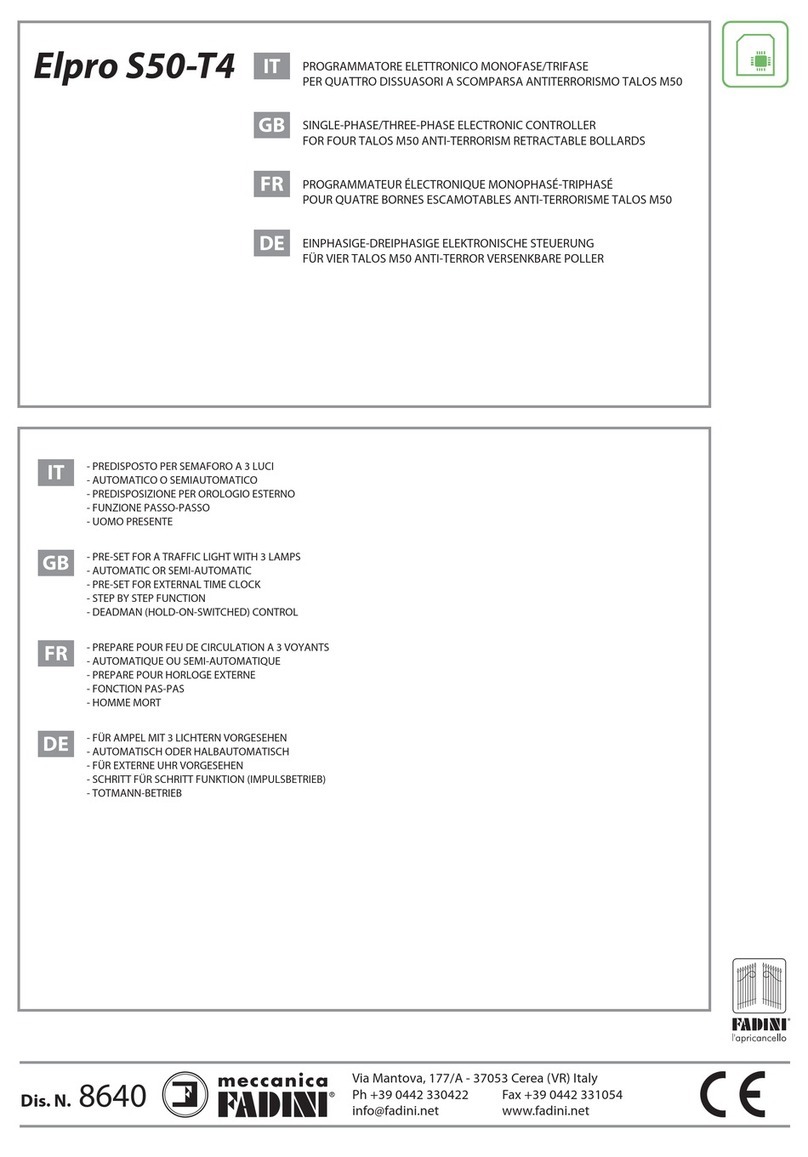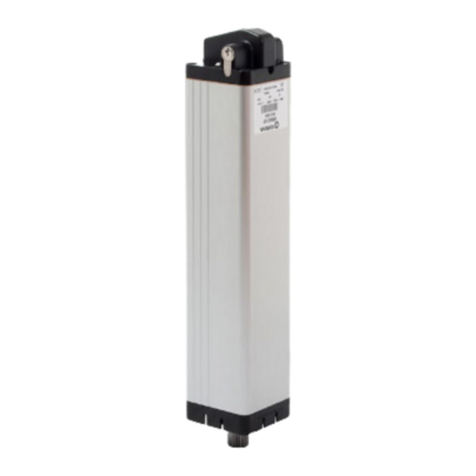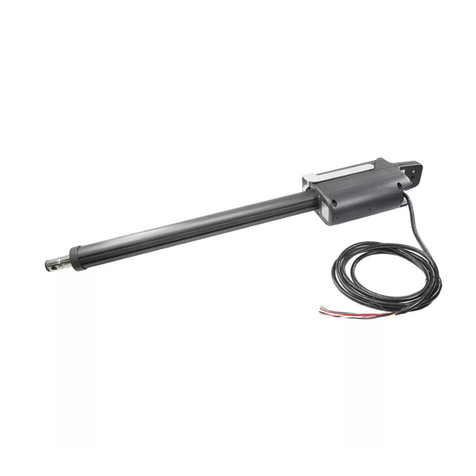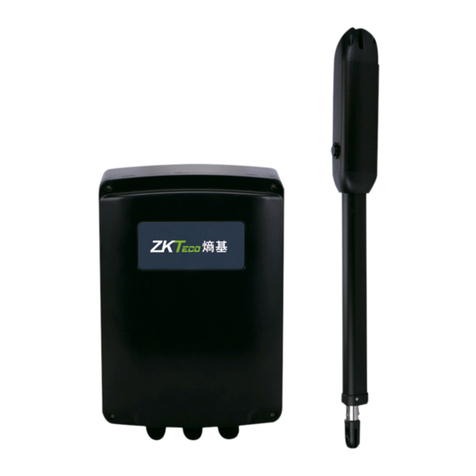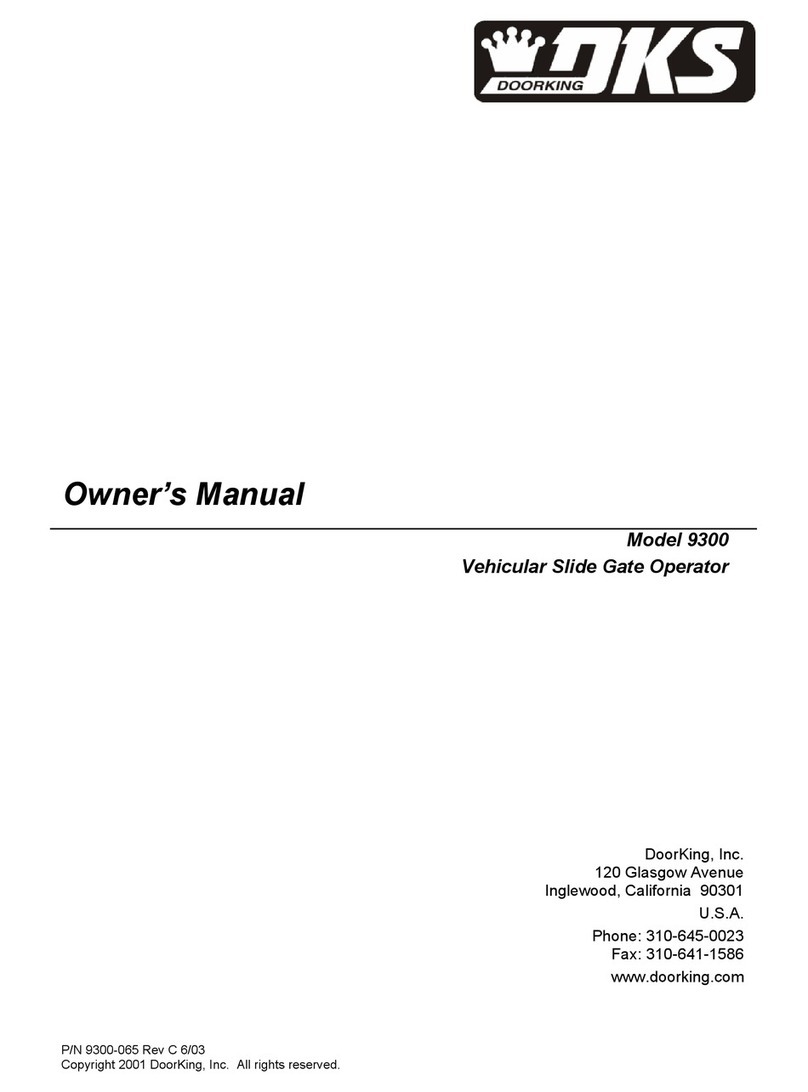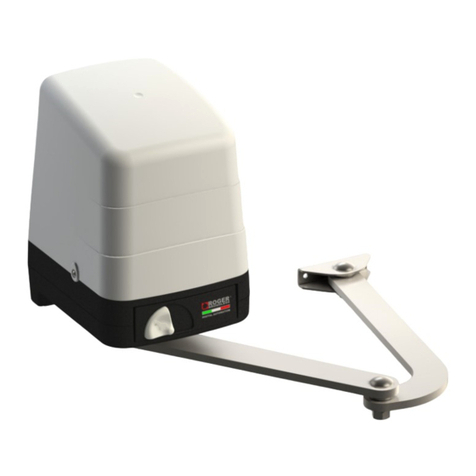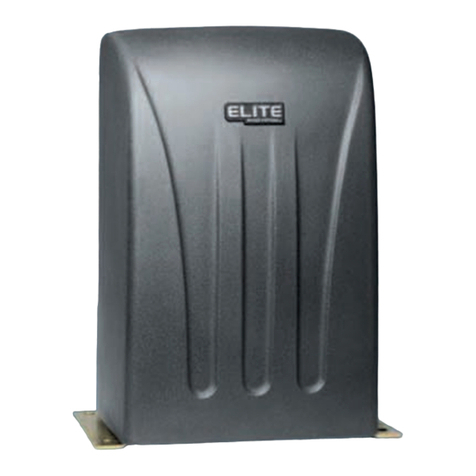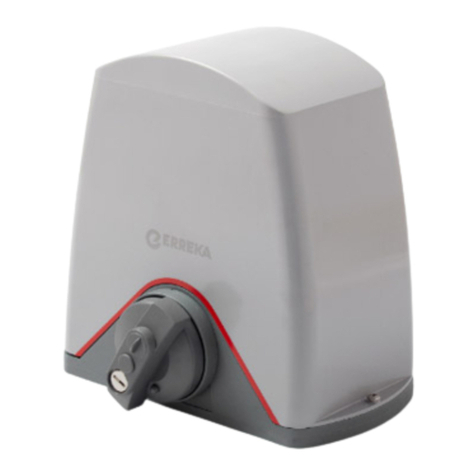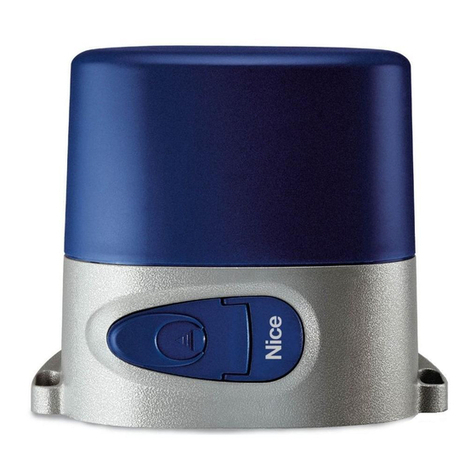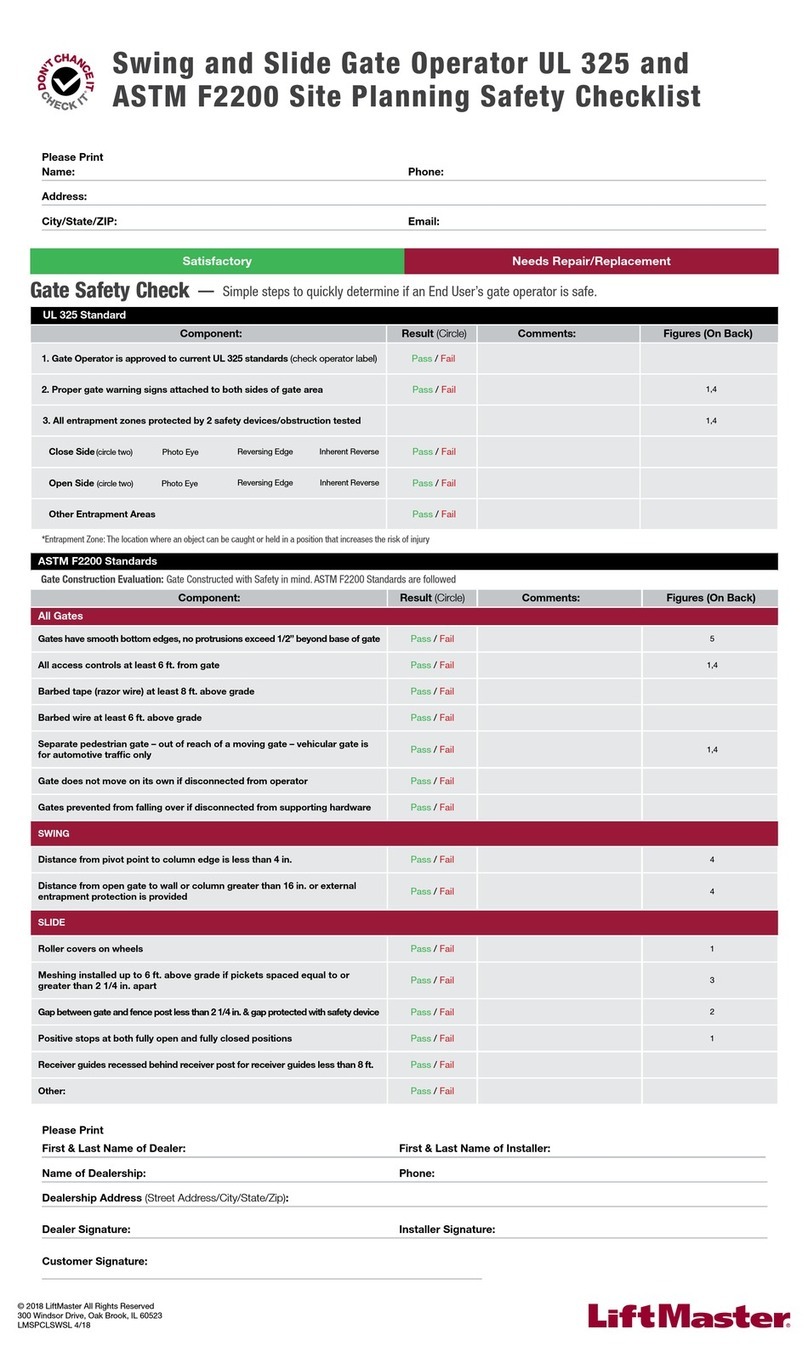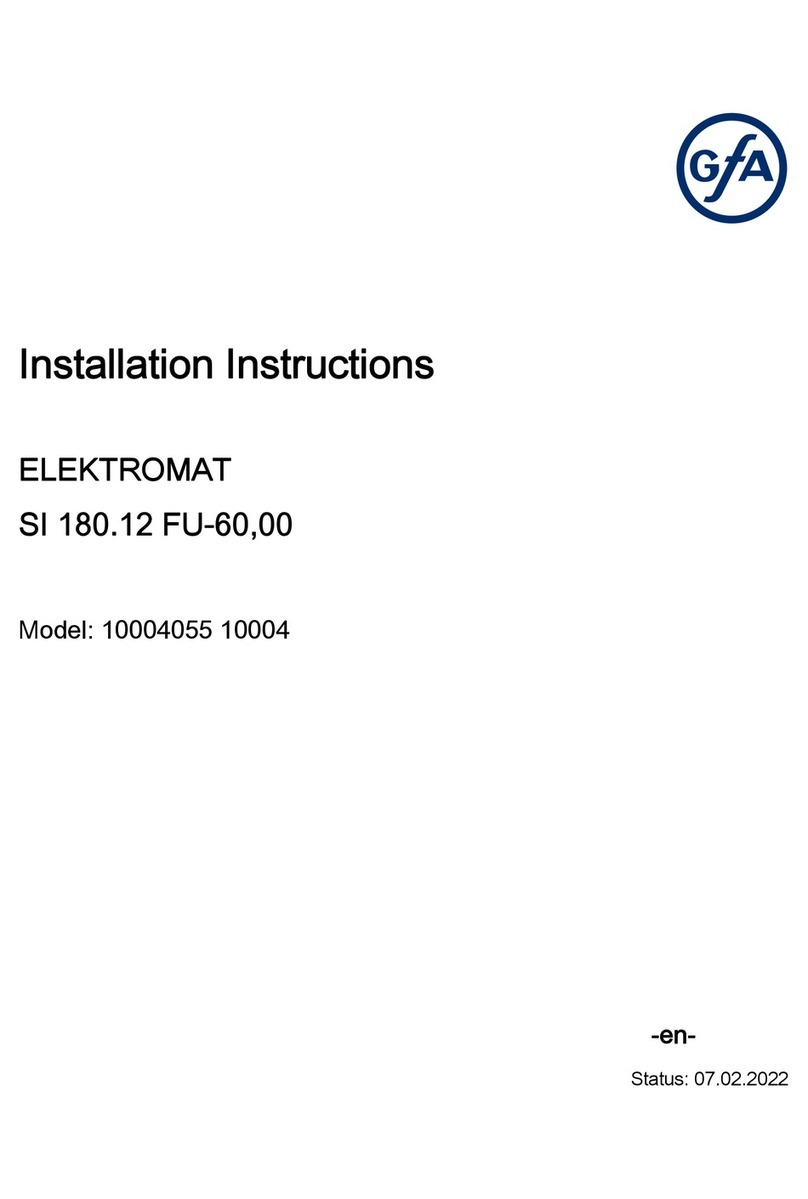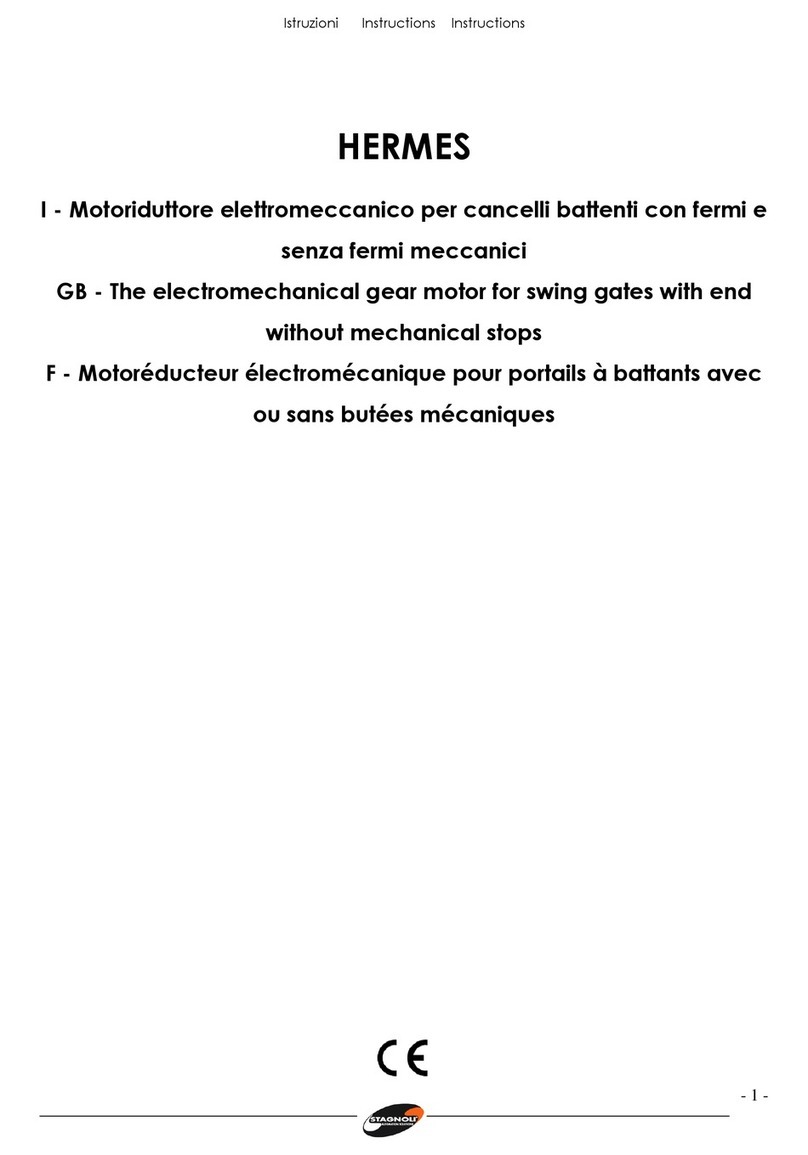tau T-ONE Series User manual

1
T-ONE SeriesEdizione 01 - anno 2008 rev. 00 - del 04/02/2009http://www.tauitalia.com
TAU srl via E. Fermi, 43 – 36066 Sandrigo (Vi) Italy – Tel. +390444750190 Fax. +390444750376 E-mail: [email protected]
For sliding gates
T-ONE Series
Manuale d’uso e manutenzione
Use and maintenance manual
Bedienungs - und Wartungsanleitung
Manuel d’emploi et d’entretien
Manual de uso y mantenimiento
AUTOMAZIONI PER CANCELLO SCORREVOLE
SLIDING GATE OPERATORS
SCHIEBETORANTRIEBE
AUTOMATISMES PORTAILS COULISSANTS
ACCIONADORES PARA CANCELAS CORREDERAS
>ITALIANO
>ENGLISH
>DEUTSCH
>FRANÇAIS
>ESPAÑOL

2
T-ONE Series
Italiano
Español
English
Français
Deutsch
I dati riportati nel presente manuale sono puramente indicativi. La TAU si riserva il diritto di modicarli in qualsiasi momento.
La Casa costruttrice si riserva il diritto di apportare modiche o miglioramenti al prodotto senza alcun preavviso. Eventuali imprecisioni
o errori riscontrabili nel presente fascicolo, saranno corretti nella prossima edizione.
All’apertura dell’imballo vericare che il prodotto sia integro. Riciclare i materiali secondo la normativa vigente.
L’installazione del prodotto dovrà essere effettuata da personale qualicato. La Ditta costruttrice Tau declina ogni responsabilità
per danni derivanti a cose e/o persone dovuti ad un’eventuale errata installazione dell’impianto o la non messa a Norma dello
stesso secondo le vigenti Leggi (vedi Direttiva Macchine).
I disegni esplosi presenti nelle ultime pagine delle presenti istruzioni sono puramente indicativi. Per i ricambi fare riferimento al relativo
listino.
Los datos describidos en este manual son puramente indicativos. La TAU se reserva el derecho de modicarlos en cualquier
momento.
El Fabricante se reserva el derecho de modicar o actualizar el producto sin aviso previo. Posibles imprecisiones o errores en este
manual serán corregidos en la próxima edición.
Cuando abra el embalaje, controle que el producto esté íntegro. Recicle los materiales según la normativa vigente.
La instalación del producto tiene que ser efectuada por personal cualicado. El Fabricante Tau no se asume ninguna
responsabilidad por lesiones a personas o averías a cosas causadas por una instalación incorrecta del equipo o la por la
inobservancia de la normativa vigente (véase Directiva de Máquinas).
Los dibujos estallados que hay en las ultimas paginas de este manual son puramente indicativos. Por los repuestos hay que hacer
referencia a la lista.
The data described in this handbook are purely a guide. TAU reserves the right to change them in any moment.
The manufacturer reserves the right to modify or improve products without prior notice. Any inaccuracies or errors found in this handbook
will be corrected in the next edition.
When opening the packing please check that the product is intact. Please recycle materials in compliance with current regulations.
This product may only be installed by a qualied tter. The manufacturer declines all liability for damage to property and/or
personal injury deriving from the incorrect installation of the system or its non-compliance with current law (see Machinery
Directive).
The exploded views on the last pages of this instruction manual are purely indicative. For the spare parts, please refer to the relevant
price list.
Les données décrites dans ce manual sont purement indicatives. La TAU se réserve le droit de les modier à n’importe quel moment.
Le Constructeur se réserve le droit d’apporter des modications ou des améliorations au produit sans aucun préavis. Les éventuelles
imprécisions ou erreurs présentes dans ce fascicule seront corrigées dans la prochaine édition.
À l’ouverture de l’emballage, vérier que le produit est intact. Recycler les matériaux suivant les normes en vigueur.
L’installation du produit devra être effectuée par du personnel qualié. Tau décline toute responsabilité pour les dommages
aux choses et/ou personnes dus à une éventuelle installation erronée de l’automatisme ou à la non-mise aux normes suivant
les lois en vigueur (voir Directive Machines).
Les plans “esplosi non lo so” qui se trouvent sur les dernières pages de ces notices techniques sont à titre indicatif. En ce qui concerne
les pièces détachées consulter la liste relative.
Die beschriebenen Daten in der vorliegenden Betriebsanleitung sind rein indikativ. TAU behält sich vor, diese in jedem Moment zu
modizieren.
Der Hersteller behält sich das Recht vor, ohne vorherige Benachrichtung Änderungen oder Verbesserungen am Produkt anzubringen.
Ungenauigkeiten oder Fehler, die in der vorliegenden Ausgabe festgestellt werden, werden in der nächsten Ausgabe berichtigt.
Beim Öffnen der Verpackung prüfen, dass das Produkt keine Schäden aufweist. Die Materialien nach den gültigen Vorschriften
recyclen.
Die Installation des Produktes muss von Fachpersonal ausgeführt werden. Die Herstellerrma TAU übernimmt keinerlei
Haftung für Personen- und/oder Sachschäden aufgrund einer falschen Installation der Anlage oder der Nichtkonformität
derselben mit den gültigen Gesetzen (siehe Maschinenrichtlinie).
Die explodierten Zeichnungen auf den letzten Seiten dieser Anleitung sind nur anzeigend. Für die Ersatzteile, bitte die entsprechende
Preisliste sehen.
D-MNL0TONE

3
T-ONE Series
DATI TECNICI - TECHNICAL DATA - DONNÉES TECHNIQUES
TECHNISCHE DATEN - DATOS TÉCNICOS
T-ONE5B T-ONE5T-ONE8
Frequenza - Frequency - Frequenz - Fréquence - Frecuencia 50 - 60 Hz 50 - 60 Hz 50 - 60 Hz
Alimentazione - Power - Stromversorgung - Alimentation - Alimentación 230 Vac 230 Vac 230 Vac
Motore - Motor - Motor - Moteur - Motor 18 Vcc 230 Vac 230 Vac
Condensatore - Condenser - Kondensator - Condensateur - Condensa-
dor -12,5 µf 12,5 µf
Corrente assorbita - Absorbed current - Stromaufnahme
Courant absorbé - Corriente absorbida 0,85 A 1,2 A 1,3 A
Potenza assorbita - Absorbed power - Leistungsaufnahme
Puissance absorbée - Potencia absorbida 160-250 VA 200 W 240 W
Velocità motore - Motor speed - Motorgeschwindigkeit
Vitesse moteur - Velocidad Motor 1500 rpm 1450 rpm 1450 rpm
Giri in uscita - Output revolutions - Drehzahl am Ausgang
Tours à la sortie - Revoluciones en salida 50 rpm 48 rpm 48 rpm
Velocità anta - Leaf speed - Flügelgeschwindigkeit
Vitesse du vantail - Velocidad hoja 10,7 m/min 10,25 m/min 10,25 m/min
Grado di protezione - Protection level - Schutzart
Degré de protection - Grado de protección IP 44 IP 44 IP 44
Ciclo di lavoro - Work cycle - Arbeitszyklus
Cycle de travail - Ciclo de trabajo 100% 30% (vedi graco) 30% (vedi graco)
Temperatura di esercizio - Operating temperature - Betriebstemperatur
Temperature de fonctionnement - Temperatura de trabajo -20°C ÷ +70°C -20°C ÷ +70°C -20°C ÷ +70°C
Rapporto di riduzione - Reduction ratio - Untersetzungsverhältnis
Rapport de réduction - Relación de reducción 1/30 1/30 1/30
Intervento termoprotezione - Thermal protection trips at
Eingreifen des Wärmeschutzes - Intervention protection thermique
Activatión termoprotección - 138°C 138°C
Peso max. cancello - Max. gate weight - Torgewicht max.
Poids max portail - Peso máximo de la cancela 500 Kg 500 Kg 800 Kg
Peso - Weight - Gewicht - Poids - Peso 10,5 Kg 11 Kg 11,5 Kg
NOTA: QUANDO IL SISTEMA IN 12 VDC È ALIMENTATO UNICAMENTE DALLA BATTERIA (IN CASO DI BLACK-OUT OPPURE
IN ABBINAMENTO CON PANNELLO FOTOVOLTAICO), LE PRESTAZIONI ESPRESSE DAL MOTORIDUTTORE (FORZA E
VELOCITÀ) SI RIDUCONO DEL 30% CA.
N.B. WHEN THE SYSTEM IS IN THE 12 V DC MODE AND IS POWERED BY THE BATTERY ONLY (IN THE EVENT OF A POWER
FAILURE OR WHEN USED IN CONJUNCTION WITH A PHOTOVOLTAIC PANEL), THE GEAR MOTOR’S OUTPUT (POWER AND
SPEED) IS REDUCED BY APPROXIMATELY 30% .
ANMERKUNG: WENN DAS 12 VDC SYSTEM NUR ÜBER BATTERIE GESPEIST IST (BEI STROMAUSFALL ODER IN
KOMBINATION MIT EINEM PHOTOVOLTAICPANEEL), VERRINGERN SICH DIE LEISTUNGEN DES GETRIEBEMOTORS (KRAFT
UND GESCHWINDIGKEIT) UM CA. 30%.
ATTENTION : QUAND LE SYSTÈME À 12 VCC EST ALIMENTÉ UNIQUEMENT PAR LA BATTERIE (EN CAS DE COUPURE DE
COURANT OU BIEN ENASSOCIATIONAVEC UN PANNEAU PHOTOVOLTAÏQUE), LES PERFORMANCES DU MOTORÉDUCTEUR
(FORCE ET VITESSE) DIMINUENT D’ENVIRON 30% .
NOTA: CUANDO EL SISTEMA DE 12 VDC ES ALIMENTADO ÚNICAMENTE POR LA BATERÍA (EN CASO DE CORTE DE
CORRIENTE, O BIEN COMBINADO CON PANEL FOTOVOLTAICO), LAS PRESTACIONES DEL MOTORREDUCTOR (FUERZA Y
VELOCIDAD) SE REDUCEN EN UN 30%.
T-ONE5B
Motoriduttore per
cancelli no a 500 Kg,
motore 12V, quadro
elettrico incorporato.
Gearmotor for gates
up to 500 Kg, 12V mo-
tor, built-in control unit.
Getriebemotor für
Tore bis 500 Kg, 12V
Motor, mit eingebauter
Steuerzentrale.
Motoréducteur pour
portails jusqu’à 500
Kg, moteur 12V, cen-
trale incorporée.
Motorreductor para
verjas de hasta 500
Kg, motor de 12V,
central incorporada.
T-ONE5
Motoriduttore per can-
celli no a 500 kg, mo-
tore 230V con quadro
elettrico incorporato.
Gearmotor for gates
up to 500 Kg, 230V
motor, built-in control
unit.
Getriebemotor für
Tore bis 500 Kg, 230V
Motor, mit eingebauter
Steuerzentrale.
Motoréducteur pour
portails jusqu’à 500
Kg, moteur 230V,
centrale incorporée.
Motorreductor para
verjas de hasta 500
Kg, motor de 230V,
centrale incorporada.
T-ONE8
Motoriduttore per can-
celli no a 800 kg, mo-
tore 230V con quadro
elettrico incorporato.
Gearmotor for gates
up to 800 Kg, 230V
motor, built-in control
unit.
Getriebemotor für
Tore bis 800 Kg, 230V
Motor, mit eingebauter
Steuerzentrale.
Motoréducteur pour
portails jusqu’à 800
Kg, moteur 230V,
centrale incorporée.
Motorreductor para
verjas de hasta 800
Kg, motor de 230V,
centrale incorporada.

4
T-ONE Series
1_ AVVERTENZE PER L’INSTALLATORE
OBBLIGHI GENERALI PER LA SICUREZZA
1) Leggere attentamente le istruzioni prima di procedere
all’installazione, in quanto forniscono importanti
indicazioni concernenti la sicurezza, l’installazione,
l’uso e la manutenzione. Una errata installazione o un
errato uso del prodotto può portare a gravi danni alle
persone.
2) I materiali dell’imballaggio (plastica, polistirolo, ecc.) non
devono essere lasciati alla portata dei bambini in quanto
potenziali fonti di pericolo.
3) Conservare le istruzioni per riferimenti futuri.
4) Questo prodotto è stato progettato e costruito esclusivamente
per l’utilizzo indicato in questa documentazione. Qualsiasi
altro utilizzo non espressamente indicato potrebbe
pregiudicare l’integrità del prodotto e/o rappresentare fonte
di pericolo.
5) TAU declina qualsiasi responsabilità derivata dall’uso
improprio o diverso da quello per cui l’automatismo è
destinato.
6) Non installare il prodotto in ambiente e atmosfera
esplosivi.
7) Gli elementi costruttivi meccanici devono essere in accordo
con quanto stabilito dalle Norme EN 12604 e EN 12605. Per
i Paesi extra-CEE, oltre ai riferimenti normativi nazionali, per
ottenere un livello di sicurezza adeguato, devono essere
seguite le Norme sopra riportate.
8) TAU non è responsabile dell’inosservanza della Buona
Tecnica nella costruzione delle chiusure da motorizzare,
nonché delle deformazioni che dovessero intervenire
nell’utilizzo.
9) Considerando i pericoli che si possono vericare durante
l’installazione e l’uso di T-ONE, per la massima sicurezza
è necessario che l’installazione avvenga nel pieno rispetto
di leggi, norme e regolamenti. In questo capitolo verranno
riportate avvertenze di tipo generico; altre importanti
avvertenze sono presenti nei capitoli “3.1 Veriche
preliminari”; “8 Collaudo e messa in servizio”.
Secondo la più recente legislazione europea, la
realizzazione di una porta o cancello automatico ricade
in quanto previsto dalla Direttiva 98/37/CE (Direttiva
Macchine) e nel particolare, alle norme: EN 12445; EN
12453 ed EN 12635, che consentono di dichiarare la
presunzione di conformità.
10) Prima di iniziare l’installazione è necessario eseguire analisi
dei rischi che comprendente l’elenco dei requisiti essenziali
di sicurezza previsti nell’allegato I della Direttiva Macchine,
indicando le relative soluzioni adottate. Si ricorda che
l’analisi dei rischi è uno dei documenti che costituiscono il
“Fascicolo tecnico” dell’automazione.
11) Vericare la necessità di ulteriori dispositivi per completare
l’automazione con T-ONE in base alla specica situazione
d’impiego ed ai pericoli presenti; devono essere considerati
ad esempio i rischi di impatto, schiacciamento, cesoiamento,
convogliamento, ecc., ed altri pericoli in genere.
12) L’installazione deve essere effettuata nell’osservanza delle
Norme EN 12453 e EN 12445.
13) Prima di effettuare qualsiasi intervento sull’impianto, togliere
l’alimentazione elettrica e scollegare le batterie.
14) Prevedere sulla rete di alimentazione dell’automazione un
interruttore onnipolare con distanza d’apertura dei contatti
uguale o superiore a 3 mm. È consigliabile l’uso di un
magnetotermico da 6A con interruzione onnipolare.
15) Vericare che a monte dell’impianto vi sia un interruttore
differenziale con soglia da 0,03 A.
16) Vericare che l’impianto di terra sia realizzato a regola
d’arte e collegarvi le parti metalliche della chiusura.
17) L’automazione dispone di una sicurezza intrinseca
antischiacciamento costituita da un controllo di coppia. E’
comunque necessario vericarne la soglia di intervento
secondo quanto previsto dalle Norme indicate al punto 12.
18) I dispositivi di sicurezza (norma EN 12978) permettono
di proteggere eventuali aree di pericolo da Rischi
meccanici di movimento, come ad es. schiacciamento,
convogliamento, cesoiamento.
19) Per ogni impianto è consigliato l’utilizzo di almeno una
segnalazione luminosa nonché di un cartello di segnalazione
ssato adeguatamente sulla struttura dell’insso, oltre ai
dispositivi citati al punto 18.
20) TAU declina ogni responsabilità ai ni della sicurezza e del
buon funzionamento dell’automazione in caso vengano
utilizzati componenti dell’impianto non di produzione TAU.
21) Per la manutenzione utilizzare esclusivamente parti originali
TAU.
22) Non eseguire alcuna modica sui componenti facenti parte
del sistema d’automazione.
23) L’automatismo non può essere utilizzato prima di aver
effettuato la messa in servizio come specicato nel
capitolo:“5 Collaudo e messa in servizio”.
24) L’installatore deve fornire tutte le informazioni relative al
funzionamento manuale del sistema in caso di emergenza
e consegnare all’Utente utilizzatore dell’impianto la “Guida
Utente” allegata al prodotto.
25) Non permettere ai bambini o persone di sostare nelle
vicinanze del prodotto durante il funzionamento.
26) Tenere fuori dalla portata dei bambini radiocomandi
o qualsiasi altro datore di impulso, per evitare che
l’automazione possa essere azionata involontariamente.
27) Il transito deve avvenire solo ad automazione ferma.
28) L’Utente utilizzatore deve astenersi da qualsiasi tentativo
di riparazione o d’intervento diretto e rivolgersi solo a
personale qualicato.
29) Prima di accedere ai morsetti interni al coperchio di
T-ONE scollegare tutti i circuiti di alimentazione; se il
dispositivo di sconnessione non è a vista apporvi un
cartello:“ATTENZIONE MANUTENZIONE IN CORSO”.
30) Manutenzione: effettuare almeno semestralmente la
verica funzionale dell’impianto, con particolare attenzione
all’efcienza dei dispositivi di sicurezza (compresa, ove
previsto, la forza di spinta dell’operatore) e di sblocco.
31) Tutto quello che non è previsto espressamente in queste
istruzioni non è permesso.
Consigliamo di riporre tutta la documentazione relativa
all’impianto all’interno o nelle immediate vicinanze della
centralina.
2_ DESCRIZIONE PRODOTTO E DESTINAZIONE
D’USO (g. 1)
T-ONE è un motoriduttore elettromeccanico per il movimento
automatico di cancelli scorrevoli per uso residenziale, dispone di
una centrale elettronica di controllo con ricevitore incorporato per
radiocomando.
L’automazione è disponibile in più versioni: in 12 Vdc e in 230
Vac.
Il sistema irreversibile garantisce il blocco meccanico dell’anta
quando il motore non è in funzione. Un comodo e sicuro sistema
di sblocco con chiave personalizzata permette la movimentazione
manuale dell’anta in caso di disservizio o di mancanza di
alimentazione.
L’automazione T-ONE è stata progettata e costruita per
controllare l’accesso veicolare. Evitare qualsiasi altro
diverso utilizzo.
1_ Motoriduttore
2_ Centrale elettronica
3_ Pignone
4_ Sblocco manuale
5_ Carter di protezione
2.1_ Limiti d’impiego e dimensioni (g. 2)
I dati relativi alle prestazioni di T-ONE5B, T-ONE5 ed T-ONE8 sono
riportati nel capitolo “CARATTERISTICHE TECNICHE” e sono gli
unici valori che consentono la corretta valutazione dell’idoneità
all’uso.
Generalmente la serie T-ONE è in grado di automatizzare cancelli
con peso no a 500Kg (T-ONE5B), 500 Kg (T-ONE5) e 800 Kg
(T-ONE8).
Curva di massimo utilizzo:
La curva consente di individuare il tempo massimo di lavoro (T) in
funzione della frequenza di utilizzo (F).
Es: Il motoriduttore T-ONE5 può funzionare ininterrottamente alla
frequenza d’utilizzo del 30%.
ITALIANO

5
T-ONE Series
Per garantire il buon funzionamento è necessario operare nel
campo di lavoro sotto la curva.
Importante: la curva è ottenuta alla temperatura di 24 °C.
L’esposizione all’irraggiamento solare diretto può determinare
diminuzioni della frequenza d’utilizzo no al 20%.
Calcolo della frequenza d’utilizzo:
E’ la percentuale del tempo di lavoro effettivo (apertura + chiusura)
rispetto al tempo totale del ciclo (apertura + chiusura + tempi
sosta).
La formula di calcolo è la seguente:
dove:
Ta = tempo di apertura
Tc = tempo di chiusura
Tp = tempo di pausa
Ti = tempo di intervallo tra un ciclo completo e l’altro
Percentuale
di lav. %
% Frecuencia
de utilización
% Fréquence
d’utilisation
% Benutzungs-
frequenz
% Duty cycle
Tempo (h) Time (h) Zeit (Std.) Temps (h) Tiempo (h)
10
10
100
90
80
70
60
50
40
30
20
234567891011 12
2.2_ Impianto tipico
In gura 3 è riportato l’impianto tipico dell’automazione di un
cancello di tipo scorrevole utilizzando T-ONE.
N° Descrizione
1Selettore a chiave
2Bordo primario sso (opzionale)
3Fotocellule
4Bordo primario mobile
5Staffa di necorsa “Aperto”
6 Cremagliera
7Bordo secondario sso (opzionale)
8Lampeggiante con antenna incorporata
9Motoriduttore
10 Staffa di necorsa “Chiuso”
11 Sistema wireless
12 Battenti a pavimento
13 Bordo secondario mobile (opzionale)
Cablaggio:
Nell’impianto tipico di gura 3 sono indicati anche i cavi necessari
per i collegamenti dei vari dispositivi; in tabella sono indicate le
caratteristiche dei cavi.
Collegamento Tipo cavo
a: Linea elettrica di alimentazione
b: Lampeggiante
c: antenna
d: Fotocellule (TX)
e: Fotocellule (RX)
f: Selettore a chiave
g: Bordo sensibile primario
h: Bordi mobili
Rif. 230 Vac 12 Vdc
a3x1,5mm² 3x1,5mm²
b2x0,5mm² 2x0,5mm²
cRG58 RG58
d2x0,5mm² (TX) 2x0,5mm² (TX)
e4x0,5mm² (RX) 4x0,5mm² (RX)
f* 3x0,5mm² 3x0,5mm²
g 2x0,5mm² 2x0,5mm²
h 2x0,5mm² 2x0,5mm²
* Se si installa anche l’art. P-300TSL, prevedere per il selettore a
chiave un cavo 5x0,5mm².
Note:
• se il cavo di alimentazione è più lungo di 30m occorre un cavo
con sezione maggiore, ad esempio 3x2,5mm² ed è necessaria
una messa a terra di sicurezza in prossimità dell’automazione.
3_ INSTALLAZIONE
L’installazione di T-ONE deve essere effettuata da
personale qualicato, nel rispetto di leggi, norme
e regolamenti e di quanto riportato nelle presenti
istruzioni.
3.1_ Veriche preliminari
Prima di procedere con l’installazione di T-ONE è necessario
eseguire questi controlli:
• Vericare che tutto il materiale da utilizzare sia in ottimo stato,
adatto all’uso e conforme alle norme.
• Vericare che la struttura del cancello sia adatta ad essere
automatizzata.
• Vericare che il peso dell’anta rientri nei limiti di impiego riportati
nel capitolo “2.1 Limiti d’impiego”
• Vericare che in tutta la corsa del cancello, sia in chiusura che
in apertura, non ci siano punti con maggiore attrito.
• Vericare che non vi sia pericolo di deragliamento dell’anta e
che non ci siano rischi di uscita dalle guide
• Vericare la robustezza degli arresti meccanici di oltrecorsa
controllando che non vi siano deformazioni anche se l’anta
dovesse sbattere con forza sull’arresto.
• Vericare che l’anta sia in equilibrio cioè non deve muoversi se
lasciata ferma in una qualsiasi posizione.
• Vericare che la zona di ssaggio del motoriduttore non sia
soggetta ad allagamenti; eventualmente prevedere il montaggio
del motoriduttore adeguatamente sollevato da terra.
• Vericare che la zona di ssaggio del motoriduttore permetta lo
sblocco ed una manovra manuale facile e sicura.
• Vericare che i punti di ssaggio dei vari dispositivi siano
in zone protette da urti e le superci siano sufcientemente
solide.
• Evitare che le parti dell’automatismo possano venir immerse in
acqua o in altre sostanze liquide
• Non porre T-ONE vicino a amme o fonti di calore; in
atmosfere potenzialmente esplosive, particolarmente acide
o saline; questo può danneggiare T-ONE ed essere causa di
malfunzionamenti o situazioni di pericolo.
• Nel caso sia presente un porta di passaggio interna all’anta
oppure una porta sull’area di movimento dell’anta, occorre
assicurarsi che non intralci la normale corsa ed eventualmente
provvedere con un opportuno sistema di interblocco
• Collegare la centrale ad una linea di alimentazione elettrica
dotata di messa a terra di sicurezza.
• La linea di alimentazione elettrica deve essere protetta da un
adeguato dispositivo magnetotermico e differenziale.
3.2_ Installazione meccanica
Individuazione del sito:
• Scegliere una posizione analoga all’area tratteggiata di g. 4
nel caso si proceda al ssaggio diretto al suolo (predisporre
uno o più tubi per il passaggio dei cavi elettrici, 1 g. 4) se
questo è in calcestruzzo, oppure come in g. 5 quando c’è da
realizzare lo scavo, g. 5A (chiusura destra) o g. 5B (chiusura
sinistra).
ITALIANO

6
T-ONE Series
• Portare manualmente l’anta in posizione di apertura.
• Appoggiare sul pignone il primo pezzo di cremagliera a livello
e saldare il nottolino lettato sul cancello come indicato in g.
11.
• Muovere manualmente il cancello, vericando che la
cremagliera sia in appoggio sul pignone e saldare il secondo e
il terzo nottolino.
• Accostare un altro elemento di cremagliera al precedente
utilizzando, per mettere in fase la dentatura dei due elementi,
un pezzo di cremagliera come indicato in g. 11.
• Muovere manualmente il cancello e saldare i tre nottolini lettati
proseguendo no alla copertura completa del cancello.
Importante rispettare le misure di installazione e la
distanza tra dente dell’ingranaggio e dente cremagliera
come indicato nelle gg. 9 e 11.
Nota: la cremagliera deve scorrere sull’ingranaggio del
motoriduttore per l’intera larghezza del proprio dente
(g. 9).
Fissaggio e regolazione pattini di necorsa (T-ONE5 - T-ONE8):
• Fissare con i relativi grani le staffe di necorsa di “Apertura” e di
“Chiusura” ai lati estremi della cremagliera come in gura 10 e
11. Occorre considerare che quando intervengono i necorsa,
l’anta si muoverà per altri 2÷3 cm; è consigliabile quindi porre
le staffe di necorsa con opportuno margine sugli arresti
meccanici.
È consigliato inoltre lubricare con un po’ d’olio il
punto di contatto del pattino di necorsa con la molla,
al ne di facilitare lo scivolamento e di evitare lo
schiacciamento di quest’ultima.
Nota: per una completa sicurezza si fa obbligo di
installare, se non presenti, i fermi meccanici (battenti
a pavimento) con tappo in gomma, come mostrato in
g. 3.
3.3_ Versione con pignone a catena: Serie T-ONEC
Il portone può altresì essere motorizzato come indicato nella g.
12. Passare la catena come indicato in gura.
Nella g. 12 si riporta inoltre il tipo di catena richiesta (passo 1/2”
x 5/16”).
3.4_ Registrazione della frizione elettronica (T-ONE5B),
elettrica (T-ONE5 e T-ONE8)
ATTENZIONE: Vericare che il valore della forza
d’impatto misurato nei punti previsti dalla norma EN
12445 sia inferiore a quanto indicato nella norma EN
12453.
• Tutti i motori della serie T-ONE sono dotati di encoder regolabile
per il rilevamento degli ostacoli durante la corsa. Con l’ apposito
potenziometro sulla scheda si può quindi impostare la coppia
massima di spinta.
3.5_ Installazione dei vari dispositivi
Effettuare l’installazione degli altri dispositivi previsti seguendo le
rispettive istruzioni. Vericare in gura 3 i dispositivi che possono
essere collegati a T-ONE.
4_ COLLEGAMENTI ELETTRICI
Prima di operare, assicurarsi che il motoriduttore non
sia elettricamente alimentato.
• Per effettuare i collegamenti, togliere il carter dal motoriduttore,
passare i cavi di alimentazione attraverso i fori ricavati sulla
contropiastra di fondazione (quando questa sia in uso) e
attraverso il corpo inferiore del motoriduttore, quindi predisporli
per il collegamento alla morsettiera della scheda di comando
alloggiata nel supporto componenti elettrici.
• Usare cavi di sezione minima di 2,5 mm² per i circuiti di potenza
(T-ONE5B) e di 1,5 mm² (T-ONE5 e T-ONE8), di 0,5 mm²per i
circuiti di comando.
Per i collegamenti alle schede comando consultare i relativi libretti
di istruzione:
- K125M per T-ONE5B;
- K580M per T-ONE5 e T-ONE8.
Preparazione della base:
• Scavare le fondazioni per almeno 15 cm. di profondità e bene
allargate. Prevedere una guaina protettiva per i cavi.
Fissaggio della contropiastra di fondazione (mod. 400CPO):
• Ultimato lo scavo preparare la contropiastra di fondazione
piegando le zanche ricavate nella piastra dalla stessa parte
dove sono stati ricavati gli inserti (1 g.6) per il ssaggio
del motoriduttore mediante viti. Ricoprire con calcestruzzo
annegando le zanche e lasciando liberi gli inserti per il ssaggio
del motoriduttore; la contropiastra dovrà essere perfettamente
piana ad 1 o 2 cm. dal livello del terreno e ad una distanza di
42 mm. circa dal cancello (g. 6).
Fissaggio della contropiastra di fondazione (mod. 400CPOR):
• Assemblare la piastra di fondazione come da g.7.
• La piastra di fondazione deve essere posizionata come da
g.7A (chiusura destra) o g.7B (chiusura sinistra) per garantire
il corretto ingranamento tra il pignone e la cremagliera.
• Eseguire un plinto di fondazione come da g.5 e murare
la piastra di fondazione prevedendo una o più guaine per il
passaggio dei cavi elettrici. Vericare la perfetta orizzontalità
della piastra con una livella. Attendere che il cemento faccia
presa.
• Predisporre i cavi elettrici per il collegamento con gli accessori
e l’alimentazione elettrica come da g.3.
Per effettuare agevolmente i collegamenti fare fuoriuscire i cavi
circa 30 cm dal foro della piastra di fondazione.
Fissaggio del motoriduttore (su contropiastra mod. 400CPO):
• Ancorare il motoriduttore con n° 4 viti M8x30 e relative rondelle,
come indicato in g. 8.
• Passare tutti i cavi attraverso i fori ricavati sulla base della
contropiastra di fondazione.
• Se la cremagliera è già presente, inserire n° 4 grani M8x30
(1 g. 8 - optionals) e n° 4 dadi M8 (2 g. 8 - optionals) per
regolare il pignone alla giusta altezza, lasciando 1÷2 mm di
gioco dalla cremagliera, vericando la perfetta orizzontalità del
motoriduttore con una livella.
Fissaggio del motoriduttore (su contropiastra mod. 400CPOR):
• Ancorare il motoriduttore alla contropiastra come indicato in g.
9, utilizzando n° 4 dadi M8 e n° 8 rondelle adeguate.
• Passare tutti i cavi attraverso i fori ricavati sulla base della
contropiastra di fondazione.
• Se la cremagliera è già presente, agire sui dadi (1 g. 9) per
regolare il pignone alla giusta altezza, lasciando 1÷2 mm di
gioco dalla cremagliera, vericando la perfetta orizzontalità del
motoriduttore con una livella.
Fissaggio della cremagliera (mod. 400CN):
• Sbloccare il motoriduttore come indicato nel paragrafo
“SBLOCCO MANUALE”.
• Aprire completamente l’anta, appoggiare sul pignone il primo
tratto di cremagliera e vericare che l’inizio della cremagliera
corrisponda all’inizio dell’anta come in gura 10. Vericare che
tra pignone e cremagliera vi sia un gioco di 1÷2 mm.
• Appoggiato sul pignone il primo pezzo di cremagliera a livello,
segnare il punto di foratura sul cancello; forare Ø 4 mm ed
avvitare la vite autolettante Ø 6,3 mm.
• Muovere manualmente il cancello, vericando che la
cremagliera sia in appoggio sul pignone e ripetere le operazioni
dal punto precedente.
• Accostare un altro elemento di cremagliera al precedente
utilizzando, per mettere in fase la dentatura dei due elementi,
l'incastro a coda di rondine come indicato in g.10.
• Muovere manualmente il cancello e procedere nelle operazioni
di ssaggio come per il primo elemento, proseguendo no alla
copertura completa del cancello.
Importante rispettare le misure di installazione e la
distanza tra dente dell’ingranaggio e dente cremagliera
come indicato nelle gg. 6 e 10.
Nota: la cremagliera deve scorrere sull’ingranaggio del
motoriduttore per l’intera larghezza del proprio dente
(g. 6).
Fissaggio della cremagliera (mod. 400CFZ12):
• Montare i tre nottolini lettati sull’elemento della cremagliera
(A g. 11) posizionandoli nella parte superiore dell’asola. In
tale modo il gioco sull’asola consentirà nel tempo le eventuali
regolazioni.
ITALIANO

7
T-ONE Series
5_ INSTALLAZIONE BATTERIA 12V (T-ONE5B)
Se si vuole dotare il proprio motoriduttore di una batteria per
garantire il funzionamento in assenza di corrente, togliere il carter
e inserirla nella apposita sede (g. 13); quindi collegare i cavi di
alimentazione alle linguette.
6_ SBLOCCO MANUALE
In assenza di tensione di linea levare il coperchietto della serratura,
inlare la apposita chiave e ruotare come indicato in g. 14.
Quindi, come in g. 15, tirare la leva verso l’esterno per ottenere la
gestione manuale del cancello.
7_ FINECORSA (T-ONE5 - T-ONE8)
La serie T-ONE (230 Vac) è studiata per fuzionare con dispositivo
di ne corsa elettro-meccanico a micro-switch.
I cavi sono collegati come in g. 16:
1= grigio (comune);
2= arancione (F.C. chiude - contatto N.C.);
3= rosso (F.C. apre - contatto N.C.);
4= grigio (comune).
Se, come rafgurato in fg. 16, quando l’ingranaggio ruota in senso
orario e la molla si sposta come indicato, la corsa non si ferma,
invertire la posizione dei li rosso ed arancione sulla morsettiera
della scheda di comando.
8_ VERIFICHE FINALI ED AVVIAMENTO
L’allacciamento dell’alimentazione a T-ONE deve
essere eseguito da personale esperto, qualicato, in
possesso dei requisiti richiesti e nel pieno rispetto di
leggi, norme e regolamenti.
Non appena viene fornita tensione a T-ONE è consigliabile fare
alcune semplici veriche:
1. Vericare che i leds sulla scheda di comando siano accesi.
2. Vericare che il motore non comandi il movimento del portone
e che il lampeggiante sia spento.
Se tutto questo non avviene occorre spegnere
immediatamente l’alimentazione alla centrale e
controllare con maggiore attenzione i collegamenti
elettrici.
Altre informazioni utili per la ricerca e la diagnosi dei guasti sono
presenti nel capitolo “7.6 Risoluzione dei problemi”.
Per gli altri parametri da impostare, apprendimento della corsa,
regolazione della frizione, rallentamento, regolazione tempo di
chiusura automatica, sensibilità rilevamento ostacoli etc., fare
riferimento alle istruzioni delle schede elettroniche.
9_ COLLAUDO E MESSA IN SERVIZIO
Questa è la fase più importante nella realizzazione dell’automazione
al ne di garantire la massima sicurezza. Il collaudo può essere
usato anche come verica periodica dei dispositivi che compongono
l’automatismo.
Il collaudo dell’intero impianto deve essere eseguito da
personale esperto e qualicato che deve farsi carico
delle prove richieste, in funzione del rischio presente
e di vericare il rispetto di quanto previsto da leggi,
normative e regolamenti, ed in particolare tutti i requisiti
della norma EN12445 che stabilisce i metodi di prova
per la verica degli automatismi per cancelli.
9.1_ Collaudo
Ogni singolo componente dell’automatismo, ad esempio bordi
sensibili, fotocellule, arresto di emergenza, ecc. richiede una
specica fase di collaudo; per questi dispositivi si dovranno
eseguire le procedure riportate nei rispettivi manuali istruzioni.
Per il collaudo di T-ONE eseguire la seguente sequenza di
operazioni:
1. Vericare che sia stato rispettato rigorosamente tutto quanto
previsto nel presente manuale ed in particolare nel capitolo “1
Avvertenze”;
2. Utilizzando i dispositivi di comando o arresto previsti (selettore
a chiave, pulsanti di comando o trasmettitori radio), effettuare
delle prove di apertura, chiusura ed arresto del cancello
e vericare che il comportamento corrisponda a quanto
previsto.
3. Vericare uno ad uno il corretto funzionamento di tutti i
dispositivi di sicurezza presenti nell’impianto (fotocellule, bordi
sensibili, arresto di emergenza, ecc.);
4. Per la verica delle fotocellule ed in particolare che non vi siano
interferenze con altri dispositivi, passare un cilindro di diametro
5 cm e lunghezza 30 cm sull’asse ottico prima vicino al TX, poi
vicino all’RX e inne al centro tra i due e vericare che in tutti
i casi il dispositivo intervenga passando dallo stato di attivo
a quello di allarme e viceversa. Inne vericare che provochi
nella centrale l’azione prevista; esempio: nella manovra di
chiusura provoca l’inversione di movimento.
5. Se le situazioni pericolose provocate dal movimento dell’anta
sono state salvaguardate mediante la limitazione della forza
d’impatto si deve eseguire la misura della forza secondo
quanto previsto dalla norma EN 12445. Se la regolazione della
“Velocità” ed il controllo della “Forza Motore” vengono usati
come ausilio al sistema per la riduzione della forza d’impatto,
provare e trovare le regolazioni che offrono i migliori risultati.
9.2_ Messa in servizio
La messa in servizio può avvenire solo dopo aver
eseguito con esito positivo tutte le fasi di collaudo di T-
ONE e degli altri dispositivi presenti. E’ vietata la messa
in servizio parziale o in situazioni “provvisorie”.
• Realizzare e conservare per almeno 10 anni il fascicolo tecnico
dell’automazione che dovrà comprendere almeno: disegno
complessivo dell’automazione, schema dei collegamenti
elettrici, analisi dei rischi e relative soluzioni adottate,
dichiarazione di conformità del fabbricante di tutti i dispositivi
utilizzati (per T-ONE utilizzare la Dichiarazione CE di conformità
allegata); copia del manuale di istruzioni per l’uso e del piano di
manutenzione dell’automazione.
• Apporre sul cancello una targhetta contenente almeno i
seguenti dati: tipo di automazione, nome e indirizzo del
costruttore (responsabile della “messa in servizio”), numero di
matricola, anno di costruzione e marchio “CE”.
• Fissare in maniera permanente in prossimità del cancello
un’etichetta o una targa con indicate le operazioni per lo
sblocco e la manovra manuale.
• Realizzare e consegnare al proprietario la dichiarazione di
conformità dell’automazione.
• Realizzare e consegnare al proprietario il manuale di “Istruzioni
ed avvertenze per l’uso dell’automazione”.
• Realizzare e consegnare al proprietario il piano di manutenzione
dell’automazione (che deve raccogliere tutte le prescrizioni
sulla manutenzione dei singoli dispositivi).
• Prima di mettere in servizio l’automatismo informare
adeguatamente ed in forma scritta il proprietario (ad esempio sul
manuale di istruzioni ed avvertenze per l’uso dell’automazione)
sui pericoli ed i rischi ancora presenti.
10_ USO
I motoriduttori della serie T-ONE sono stati progettati per
movimentare cancelli a scorrimento orizzontale con ante di peso
massimo di Kg. 500 (T-ONE5B), di Kg. 500 (T-ONE5) e di Kg. 800
(T-ONE8).
Si fa espresso divieto di utilizzare l’apparecchio
per scopi diversi o in circostanze diverse da quelle
menzionate.
La centralina elettronica installata consente di selezionare il
funzionamento:
automatico: un impulso di comando esegue l’apertura e la
chiusura del cancello;
semiautomatico: un impulso di comando esegue l’apertura o la
chiusura del cancello;
In caso di mancanza di energia elettrica, il cancello può funzionare
ugualmente grazie alla possibilità di gestione manuale, per la
quale è necessario agire sul dispositivo di sblocco manuale. Il
modello T-ONE5B, alimentabile con batteria tampone, garantisce
il normale funzionamento dell’automazione anche in caso di
mancanza di tensione di rete.
Si ricorda che si è in presenza di un dispositivo automatico e
alimentato con corrente, perciò nell’utilizzo devono essere usate le
ITALIANO

8
T-ONE Series
dovute precauzioni. In particolare, si raccomanda di:
• non toccare l’apparecchio con mani bagnate e/o piedi bagnati
o nudi;
• togliere la corrente prima di aprire la scatola comandi e/o il
motoriduttore;
• non toccare il motore se non siete sicuri che sia raffreddato;
• mettere in movimento il cancello solo quando è completamente
visibile;
• tenersi fuori dal raggio di azione del cancello se questo è in
movimento: aspettare no a che non sia fermo;
• non lasciare che bambini o animali giochino in prossimità del
cancello;
• non lasciare che bambini o incapaci usino il telecomando o altri
dispositivi di azionamento;
• effettuare una manutenzione periodica;
• in caso di guasto, togliere l’alimentazione e gestire il cancello
manualmente solo se possibile e sicuro. Astenersi da ogni
intervento e chiamare un tecnico autorizzato.
SI FA ESPRESSO DIVIETO DI LAVARE L’AUTOMAZIONE
UTILIZZANDO IDROPULITRICI O DISPOSITIVI SIMILARI.
È SEVERAMENTE VIETATO INDIRIZZARE GETTI
D’ACQUA DIRETTAMENTE SULL’AUTOMAZIONE.
11_ MANUTENZIONE
I motoriduttori della serie T-ONE necessitano di poca manutenzione.
Tuttavia il loro buon funzionamento dipende anche dallo stato del
cancello: perciò descriveremo brevemente le operazioni da fare
per avere un cancello sempre efciente.
Attenzione: nessuna persona ad eccezione del
manutentore, che deve essere un tecnico specializzato,
deve poter comandare il cancello automatico durante
la manutenzione.
Si raccomanda perciò di togliere l’alimentazione di rete evitando
così anche il pericolo di shock elettrici. Se invece l’alimentazione
dovesse essere presente per talune veriche, si raccomanda di
controllare o disabilitare ogni dispositivo di comando (telecomandi,
pulsantiere etc..) ad eccezione del dispositivo usato dal
manutentore.
Manutenzione ordinaria
Ciascuna delle seguenti operazioni deve essere fatta quando
se ne avverte la necessità e comunque ogni 6 mesi per un uso
domestico (circa 3000 cicli di lavoro) e ogni 2 mesi per un uso
intensivo, es. condominiale (sempre ogni 3000 cicli di lavoro).
Cancello
- Lubricare (con oliatore) le ruote di scorrimento del cancello;
- Vericare la pulizia e la tenuta della cremagliera;
Impianto di automazione
- Verica funzionamento dispositivi di sicurezza (fotocellule,
costa pneumatica, limitatore di coppia, etc..);
Manutenzione straordinaria
Se dovessero rendersi necessari interventi non banali su parti
meccaniche, si raccomanda la rimozione del motoriduttore per
consentire una riparazione in ofcina dai tecnici della casa madre
o da essa autorizzati.
12_ ACCESSORI OPZIONALI
La gamma dei motori della serie T-ONE è completata dai seguenti
accessori opzionali:
•P-650ESE03 sblocco manuale esterno provvisto di blindino;
• P-400FCM necorsa magnetico.
13_ RUMOROSITÀ
Il rumore aereo prodotto dal motoriduttore in condizioni normali di
utilizzo è costante e non supera i 70 dB.
14_ DEMOLIZIONE
L’eliminazione dei materiali va fatta rispettando le norme vigenti.
Nel caso di demolizione dell’automazione non esistono particolari
pericoli o rischi derivanti dall’automazione stessa.
È opportuno, in caso di recupero dei materiali, che siano separati
per tipologia (parti elettriche - rame - alluminio - plastica - etc...).
15_ SMANTELLAMENTO
Nel caso l’automazione venga smontata per essere poi rimontata
in altro sito è necessario:
- togliere l’alimentazione e scollegare tutto l’impianto elettrico;
- rimuovere il motoriduttore dalla base di ssaggio;
- smontare tutti i componenti dell’impianto;
- nel caso alcuni componenti non possano essere rimossi o
risultino danneggiati, provvedere alla loro sostituzione.
16_ MALFUNZIONAMENTO: CAUSE E RIMEDI
Il cancello non apre, il motore non gira.
- Vericare che fotocellule o coste sensibili non siano sporche,
impegnate o non allineate. Procedere di conseguenza.
- Vericare che l’apparecchiatura elettronica sia regolarmente
alimentata, controllare l’integrità dei fusibili.
- Mediante i leds di diagnosi della centralina (vedere le rispettive
istruzioni), controllare se le funzioni sono corrette. Individuare
eventualmente la causa del difetto. Se i leds indicano che
persiste un comando di start, controllare che non vi siano
radiocomandi, pulsanti di start o altri dispositivi che mantengono
attivato (chiuso) il contatto di start.
- Se la centralina non funziona, sostituirla.
Nel caso le condizioni sopra elencate diano esito negativo,
sostituire il motoriduttore.
Il cancello non apre, il motore gira ma non avviene il
movimento.
- Lo sblocco manuale è rimasto inserito. Ripristinare il
funzionamento motorizzato.
- Controllare se il cancello è in battuta negli arresti meccanici
di necorsa. Sbloccare manualmente il cancello, muoverlo
e ripristinare il funzionamento motorizzato. Controllare e
correggere la posizione dei pattini necorsa.
- Controllare che non vi siano difetti di assetto meccanico del
cancello.
Nel caso le condizioni sopra elencate diano esito negativo,
sostituire il motoriduttore.
ITALIANO

9
T-ONE Series
1_ INSTALLATION WARNINGS
GENERAL SAFETY REQUIREMENTS
1) Carefully read all instructions before installation,
as they provide important instructions regarding
the safety, installation, operation and maintenance.
Incorrect installation or use of the product may lead to
serious physical injury.
2) Never leave packaging materials (plastic, polystyrene etc.)
within the reach of children as they constitute a potential
hazard.
3) Keep the instructions in a safe place for future
consultation.
4) This product has been designed and constructed exclusively
for the use specied in this documentation. Any other use
not specied herein may impair product integrity and/or
constitute a hazard.
5) TAU declines all liability for improper use or use other than
as specied for this automation.
6) Never install the product in explosive atmospheres.
7) The mechanical elements must comply with the requirements
as stated in the standards EN 12604 and EN 12605. For
non European member states, in addition to the national
reference standards, the above-mentioned standards must
be observed to ensure an adequate level of safety.
8) TAU is not responsible for failure to observe Good Practice
in construction of the gates/doors to be power-operated,
nor any deformations occurring during use.
9) Considering the hazards that may occur during installation
and use of T-ONE, maximum safety is only ensured if the
product is installed in strict observance of current legislation,.
standards and regulations. This chapter contains general
warnings, while other important warnings are provided
in chapters “3.1 Preliminary checks” and “8. Testing and
commissioning”.
According to the most recent legislation, the
installation of a power-operated gate or door must
be in full observance of the standards envisaged by
European Directive 98/37/EC (Machinery Directive) and
in particular the standards: EN 12445; EN 12453 and
EN 12635, which enable the declaration of presumed
conformity.
10) Before installation, an assessment of the associated risks
must be made, including a list of the essential safety
requirements as envisaged in Appendix I of the Machinery
Directive, specifying the relative solutions adopted. Note
that the risk assessment is one of the documents included
in the automation Technical documentation.
11) Check whether other devices are needed to complete the
T-ONE automation on the basis of the specic conditions
of use and dangers present; take into account all risks of
impact, crushing, shearing, dragging etc. and other hazards
in general.
12) Installation must be performed in compliance with the
standards EN 12453 and EN 12445.
13) Before performing any operations on the system, disconnect
from the mains and detach the batteries.
14) On the automation power line, install a device for
disconnection from the power mains with a gap between
contacts equal to or greater than 3 mm. Use of a 6A
thermal magnetic circuit breaker with multi-pole switch is
recommended.
15) Check upline of the system that there is a residual current
circuit breaker with a threshold of 0.03 A.
16) Ensure that the earthing system is to professional standards
and connected to the metal section of the gate/door.
17) The automation is equipped with an intrinsic anti-crushing
safety device comprising a torque control. The trip threshold
must in all cases be checked as stated in the standards
specied in point 12.
18) The safety devices (standard EN 12978) enable the
protection of danger areas from risks associated with
mechanical movements such as crushing, dragging and
shearing.
19) The use of at least one luminous indicator is recommended
for each system, as well as a warning notice xed suitably
to the frame structure, in addition to the devices specied in
point 18.
20) TAU declines all liability for the safety and efcient operation
of the automation in the event of using system components
not produced by TAU.
21) For maintenance, use exclusively original TAU parts.
22) Never modify components that are part of the automation
system.
23) The automation may only be used after completing the
commissioning procedure as specied in chapter 5 “Testing
and commissioning”.
24) The installer must provide all information regarding manual
operation of the system in the event of an emergency and
supply the system User with the “User Guide” enclosed with
the product.
25) Never allow children or other persons to stay in the vicinity
of the product during operation.
26) Keep all radio controls or other pulse supplier device out of
the reach of children to prevent inadvertent activation of the
automation.
27) Transit should only occur with the automation stationary.
28) The user must never attempt to repair or intervene directly
on the product; always contact qualied personnel for
assistance.
29) Before accessing internal terminals under the cover of T-
ONE, disconnect all power circuits. If the disconnect device
is not in a visible location, afx a notice stating “CAUTION:
MAINTENANCE IN PROGRESS”.
30) Maintenance: at least every six months, make a general
check of the system, with special reference to the efciency
of the safety devices (including, when envisaged, the
operator thrust force) and release mechanisms.
31) All actions not expressly envisaged in these instructions are
strictly prohibited.
All documentation related to the system should be kept inside
or in the immediate vicinity of the control unit.
2_ PRODUCT DESCRIPTION AND INTENDED USE
(g. 1)
T-ONE is an electromechanical gearmotor for the automatic
movement of sliding gates for residential applications, and is
equipped with an electronic control unit with built-in receiver for
radio control.
There are several versions available: 12 Vdc and 230 Vac.
The irreversible system guarantees mechanical blocking of the
gate when the motor is not operating. A practical and safe release
system with personalised key enables manual movement of the
gate in the event of a malfunction or power failure.
The T-ONE operator has been designed and
constructed to control vehicle access. Never use for
other purposes.
1_ Gearmotor
2_ Electronic control unit
3_ Pinion
4_ Manual release
5_ Protection guard
2.1_ Product application limits and dimensions (g. 2)
The data regarding the performance of T-ONE5B, T-ONE5 and T-
ONE8 are stated in the chapter “TECHNICAL SPECIFICATIONS”
and are the only values that ensure the correct assessment for
suitability of use.
In general the series T-ONE is able to automate gates with a
weight of up to 500Kg (T-ONE5B), 500 Kg (T-ONE5) and 800 Kg
(T-ONE8).
Maximum operating curve:
This curve enables identication of the maximum operating time
(T) according to the frequency of use (F).
E.g.: The T-ONE5 gearmotor can operate without interruption at a
frequency of use of 30%.
ENGLISH

10
T-ONE Series
To guarantee optimal operation, the unit must operate within the
operating range below the curve.
Important: the curve is obtained at a temperature of 24 °C.
Exposure to direct sunlight may reduce the frequency of use by
up to 20%
Calculating the frequency of use:
This is the percentage of the effective operating time (opening
and closing) with respect to the total time of the cycle (opening +
closing + pause time).
The calculation formula is as follows:
where:
Ta = Opening time
Tc = Closing time
Tp = Pause time
Ti = Interval time between one complete cycle and the next
Percentuale
di lav. %
% Frecuencia
de utilización
% Fréquence
d’utilisation
% Benutzungs-
frequenz
% Duty cycle
Tempo (h) Time (h) Zeit (Std.) Temps (h) Tiempo (h)
10
10
100
90
80
70
60
50
40
30
20
234567891011 12
2.2_ Typical system
Figure 3 shows a typical automation system for a sliding gate using
T-ONE.
N° Description
1Key-operated selector switch
2Fixed primary edge (optional)
3Photocells
4Mobile primary edge
5“Open” limit switch bracket
6 Rack
7Secondary xed edge (optional)
8Flashing light with built-in aerial
9 Gearmotor
10 “Closed” limit switch bracket
11 Wireless system
12 Floor-mounted end stops
13 Secondary mobile edge (optional)
Wiring:
The typical system in gure 3 also shows the cables required
for connecting the various devices; the table species the cable
specications.
Connection Cable type
a: Mains power line
b: Flashing light
c: Antenna
d: Photocells (TX)
e: Photocells (RX)
f: Key-operated selector switch
g: Primary sensitive edge
h: Mobile edges
Ref. 230 Vac 12 Vdc
a3x1,5mm² 3x1,5mm²
b2x0,5mm² 2x0,5mm²
cRG58 RG58
d2x0,5mm² (TX) 2x0,5mm² (TX)
e4x0,5mm² (RX) 4x0,5mm² (RX)
f* 3x0,5mm² 3x0,5mm²
g 2x0,5mm² 2x0,5mm²
h 2x0,5mm² 2x0,5mm²
* If art. P-300TSL is also installed, envisage a cable 5x0.5 mm for
the key selector switch.
Notes:
• If the power cable is longer than 30 m, a cable with a larger
cross-section is required (3 x 2.5 mm2) and safety earthing is
necessary in the vicinity of the automation.
3_ INSTALLATION
T-ONE must be installed by qualied personnel,
in compliance with local legislation, standards,
regulations and these instructions.
3.1_ Preliminary checks
Before installing T-ONE, perform the following checks:
• Ensure that all material used is in perfect condition, suitable for
use and compliant with standards.
• Ensure that the gate structure is suitable for automation.
• Ensure that the weight of the leaf is within the application limits
as specied in paragraph 2.1 “Application limits”
• Ensure that there are no points of increased friction at any point
of gate travel, both in opening and closing.
• Ensure that there is no risk of gate derailing or risks of exit from
the tracks
• Check resistance of the mechanical overtravel stops, ensuring
there are no deformations even if the gate impact is strong on
stopping.
• Check that the leaf is balanced and therefore does not move if
left stationary in any position.
• Make sure that the xing zone is not subject to ooding. If
necessary, mount the gearmotor raised from the ground.
• Ensure that the gearmotor xing zone enables safe and easy
manual movement and release.
• Ensure that the selected surfaces for installation of the various
devices are solid, protected from the risk of impact and
guarantee a stable xture.
• Ensure that parts of the automation cannot come into contact
with water or other liquids
• Never place T-ONE in the vicinity of ames or heat sources; in
potentially explosive, particularly acid or saline atmospheres,
this may damage T-ONE and cause malfunctions or hazardous
situations.
• If the gate leaf incorporates a pedestrian access door or if this
door is positioned in the gate movement area, ensure that
this does not prevent normal gate travel; if necessary install a
compatible interlock system
• Connect the control unit to an electric power line equipped with
an earthing system.
• The mains power line must be protected by an adequate
thermal magnetic and residual current circuit breaker device.
3.2_ Mechanical installation
Site location:
• Choose a position similar to the outlined area in g. 4 when
xing the unit directly to the ground (lay one or two conduits
for routing electrical wiring, 1 g. 4) if in concrete, or as shown
in g. 5 when an excavation is required, g. 5A (right-hand
closure) or g. 5B (left-hand closure).
Base preparation:
• Dig the foundations to a depth of at least 15 cm with sufcient
width. Fit a protective sheath for routing the electric cables.
ENGLISH

11
T-ONE Series
Fixing the foundation plate assembly (model 400CPO):
• On completion of excavations, prepare the foundation plate
assembly by bending the anchor elements in the plate on
the same section mounting the inserts (1, g. 6) for xing the
gearmotor by means of screws. Embed the anchor elements
in concrete while leaving the inserts exposed for gearmotor
xture; the foundation plate assembly must be perfectly at at
1 or 2 cm from ground level and at a distance of approx. 42 mm
from the gate (g. 6).
Fixing the foundation plate assembly (model 400CPOR):
• Assemble the foundation plate as shown in g. 7.
• The foundation plate must be positioned as shown in g.7A
(right-hand closure) or g.7B (left-hand closure) to guarantee
correct meshing of the pinion and rack.
• Make a foundation plinth as shown in g. 5 and install the
foundation plate, envisaging one or more conduit sheaths for
routing the electric cables. Check perfect positioning of the
plate using a spirit level. Wait for the cement to set.
• Lay the electric cables for connection to the accessories and
electrical mains as shown in g. 3.
To facilitate connections, leave an excess length of cables of
approx. 30 cm from the hole in the foundation plate.
Fixing the gearmotor (on foundation plate assembly model
400CPO):
• Anchor the gearmotor using 4 screws M8x30 and relative
washers, as shown in g. 8.
• Pass all cables through the holes on the base of the foundation
plate assembly.
• If the rack is already present, insert the 4 stud bolts M8x30 (1
g. 8 - optional) and 4 nuts M8 (2 g. 8 - optional) to adjust the
pinion at the correct height, leaving 1÷2 mm of play from the
rack, checking perfect levelling of the gearmotor with a spirit
level.
Fixing the gearmotor (on foundation plate assembly model
400CPOR):
• Anchor the gearmotor to the foundation plate assembly as
shown in g. 9, using 4 nuts M8 and 8 washers.
• Pass all cables through the holes on the base of the foundation
plate assembly.
• If the rack is already present, adjust nuts (1 g. 9) to set the
pinion at the correct height, leaving 1÷2 mm of play from the
rack, checking perfect levelling of the gearmotor with a spirit
level.
Fixing the rack (model 400CN):
• Release the gearmotor as described in the paragraph “MANUAL
RELEASE”.
• Open the leaf completely, position the rst section of the rack
aligned with the edge of the gate and check that the start of the
rack corresponds to the start of the leaf as shown in gure 10.
Check that there is a clearance of 1÷2 mm between the pinion
and rack.
• After positioning the rst section of the rack aligned with the
edge of the gate, mark the drilling point on the gate, drill a Ø 4
mm hole and insert the self-tapping screw Ø 6,3 mm.
• Manually move the gate, checking that the rack is positioned on
the pinion and repeat the operations described in the previous
point.
• Move another rack element up against the previous one, using
the dovetail connection to mesh the teeth of the two elements
as shown in g. 10.
• Manually move the gate and proceed with the xing operations
as per the rst element, through to complete coverage of the
gate.
It is very important to observe the installation
measurements and distance between the gear teeth
and rack teeth as shown in gures 6 and 10.
Note: the rack must slide on the gear of the gearmotor
throughout the entire length of its tooth (g. 6).
Fixing the rack (model 400CFZ12):
• Mount the three threaded pawls on the rack element (A g.
11) positioning them on the upper section of the slot. This
will ensure clearance on the slot for future adjustments when
required.
• Manually move the leaf to the opening position.
• Position the rst section of the rack aligned with the edge of the
gate, and weld the threaded pawl onto the gate as shown in g.
11.
• Manually move the gate, checking that the rack is positioned
on the pinion and weld the second and third pawl.
• Move another rack element up against the previous one, using
a rack element to mesh the teeth of the two elements as shown
in g. 11.
• Manually move the gate and weld the three threaded pawls
through to complete coverage of the gate.
It is very important to observe the installation
measurements and distance between the gear teeth
and rack teeth as shown in gures. 9 and 11.
Note: the rack must slide on the gear of the gearmotor
throughout the entire length of its tooth (g. 9).
Fixing and adjusting the limit switch pads (T-ONE5 - T-ONE8):
• With the relative stud bolts, x the “opening” and “closing” limit
switch brackets at the ends of the rack as shown in gure 10
and 11. Take into consideration that when the limit switches
trip, the leaf continues to move by a further 2÷3 cm; therefore
the limit switch brackets should be positioned with a suitable
margin on the mechanical stops.
It is also recommended to slightly lubricate the point
of contact of the limit switch pad with the spring, to
facilitate sliding and prevent compression of the latter.
Note: to ensure complete safety, mechanical stops
(oor-mounted end stops), if not already present, with
rubber caps MUST be tted, as shown in g. 3.
3.3_ Version with chain pinion: T-ONEC Series
The door can also be power-operated as shown in g. 12. Pass the
chain as shown in g.
Fig. 12 also shows the type of chain required (pitch 1/2” x 5/16”).
3.4_ Adjustment of the electronic clutch (T-ONE5B),
and electric clutch (T-ONE5 - T-ONE8)
IMPORTANT: Ensure that the impact force measured at
the points as envisaged by the standard EN 12445 is
less than the value specied in standard EN 12453.
• All motors in the T-ONE series are equipped with a settable
encoder for obstacle detection during travel. The maximum
thrust torque can then be set by means of the relative
potentiometer on the card.
3.5_ Installation of various devices
To install the other devices envisaged, refer to the relevant
instructions. Check in gure 3 the devices that can be connected
to T-ONE.
4_ ELECTRICAL CONNECTIONS
Before proceeding, ensure that the gearmotor is not
connected to the electrical mains.
• To make the connections, remove the cover from the gearmotor,
route the power cables through the holes on the foundation
plate assembly (if used) and through the lower body of the
gearmotor, then prepare them for connection to the terminal
board of the control card housed in the electrical components
support.
• Use cables with a minimum section of 2.5 mm² for the power
circuits (T-ONE5B) and 1.5 mm² (T-ONE5 e T-ONE8), 0.5 mm²
for the control circuits.
For connections to the control cards consult the relative instruction
booklets:
- K125M for T-ONE5B;
- K580M for T-ONE5 and T-ONE8.
ENGLISH

12
T-ONE Series
5_ 12V BATTERY INSTALLATION (T-ONE5B)
If a battery is to be tted on the gearmotor to guarantee operation
in the event of a power failure, remove the cover and insert it in the
relative seat (g. 13); then connect the power cables to the tabs.
6_ MANUAL RELEASE
In the event of a power failure, raise the cover from the lock, insert
the relative key and turn as shown in g. 14.
Then, as shown in g. 15, pull the lever outwards to enable manual
movement of the gate.
7_ LIMIT SWITCH (T-ONE5 - T-ONE8)
The series T-ONE (230 Vac) has been designed to operate with an
electro-mechanical micro-switch type limiter.
The cables are connected as shown in g. 16:
1= grey (common);
2= orange (F.C. close - NC contact);
3= red (F.C. Open - NC contact);
4= grey (common).
As shown in g. 16, when the gear rotates clockwise and the spring
moves as shown, if gate travel does not stop, invert the position
of the red and orange wires on the terminal board of the control
card.
8_ FINAL CHECKS AND START-UP
T-ONE must be connected to the power mains by
skilled and qualied personnel, in possession of
all requirements for full compliance with all legal
provisions, standards and regulations.
Immediately after powering up T-ONE, perform a number of simple
checks:
1. Ensure that the leds on the control card are lit.
2. Ensure that the motor does not activate any gate movement
and that the ashing light is off.
If this is not so, disconnect the control unit from the
power supply immediately and check the electrical
connections carefully.
Other useful information for troubleshooting can be found in chapter
7.6 “Troubleshooting”.
For other parameter settings, such as gate travel learning, clutch
adjustment, deceleration, automatic closure time, obstacle
detection sensitivity etc., refer to the instructions of the electronic
cards.
9_ TESTING AND COMMISSIONING
This is the most important phase of automation set-up to ensure
maximum system safety. The test can also be performed as a
periodic check of automation devices.
Testing of the entire system must be performed by skilled
and qualied personnel, who are responsible for the
tests required to verify the solutions adopted according
to the risks present, and for ensuring observance of
all legal provisions, standards and regulations, with
particular reference to all requirements of the standard
EN12445 which establishes the test methods for testing
automations for power-operated gates.
9.1_ Testing
Each automation component, such as sensitive edges, photocells,
emergency stop, etc., requires a specic testing phase; for
these devices take care to follow the procedures specied in the
respective instruction manual.
To test T-ONE, perform the following sequence of operations:
Ensure that all specications in this manual, and in particular
chapter “1 WARNINGS” have been strictly observed;
2. Using the control or stop devices envisaged (key-operated
selector switch, control pushbuttons, radio transmitters, etc.)
perform gate opening and closing tests, ensuring that the leaf
movement corresponds to specications.
3. Check operation of all system safety devices one at a time
(photocells, sensitive edges, emergency stop etc.);
4. To test photocells and in particular that there is no interference
with other devices, pass a cylinder (diameter 5 cm, length 30
cm) through the optic axis joining the pair of photocells, rst
close to the TX and then the RX and then mid-way between
the two. Ensure that in all cases the device engages, changing
from the active status to alarm status and vice versa. Also
check that the envisaged action is generated in the control
unit, for example: that during the Closing manoeuvre, the door
inverts the current movement.
5. If hazardous situations generated by the moving leafs are
protected by means of impact force limitation, measure the
force as specied in the standard EN 12445. If the settings
“speed” and “gearmotor force” control are used as an auxiliary
function with the system for reduction of impact force, test and
identify the setting that obtains the best results.
9.2_ Commissioning
Commissioning can only be performed after positive
results of all test phases on T-ONE and other devices
present. Partial or “makeshift” commissioning is
strictly prohibited.
• Prepare the automation technical documentation (to be
conserved for at least 10 years), which must contain the following
documents: an overall layout diagram of the automation,
electrical wiring diagram, risk assessment and relative solutions
adopted, manufacturer’s declaration of conformity for all
devices used (for T-ONE use the CE declaration of conformity
enclosed) copy of instruction manual for operation and the
automation maintenance schedule.
• Afx a dataplate on the gate, specifying at least the following
data: type of automation, name and address of manufacturer
(responsible for commissioning), serial number, year of
construction and CE mark.
• Permanently x a label or plate in the vicinity of the gate, stating
the procedures for release and manual manoeuvres.
• Compile the automation declaration of conformity and deliver
to the owner.
• Compile the manual “Instructions and warnings for automation
operation” and deliver to the owner.
• Prepare the automation maintenance schedule (including all
instructions for the maintenance of individual devices) and
deliver to the owner.
• Before commissioning the automation, ensure that the owner
is adequately informed in writing of all associated risks and
hazards (for example of the manual of instructions and warnings
for automation operation).
10_ OPERATION
The gearmotors in the series T-ONE have been designed to move
horizontal sliding gates with leafs of a maximum weight of 500 kg
(T-ONE5B), 500 kg (T-ONE5) and 800 kg (T-ONE8).
Use of the device for other purposes or in other
circumstances than as specied is strictly prohibited.
The electronic control unit installed enables selection of the
operating mode:
automatic: a control pulse activates gate opening and closing;
semiautomatic: a control pulse activates gate opening or closing;
In the event of a power failure, the gate can still operate thanks
to the option of manual control, possible by means of the manual
release device.
The model T-ONE5B, with the optional battery power supply
guarantees normal automation operation also in the event of a
power failure.
Note that this is an automatic device and mains powered, and
therefore when used the due precautions must be taken. The
following in particular is recommended:
• Never touch the device with wet hands and/or wet or bare
feet;
• Disconnect the power supply before opening the controls box
and/or gearmotor;
• Never touch the motor before ensuring it is completely cool;
• Only move the gate when it is completely visible;
ENGLISH

13
T-ONE Series
• Keep away from the operating range of the gate when in
movement: wait until it is stationary;
• never allow children or animals to play in the vicinity of the
gate;
• never allow children or unskilled persons to use the remote
control or other activation devices;
• Perform periodic maintenance;
• In the event of a fault, disconnect the power supply and only
move the gate manually when possible and in safety. Do
not intervene on the gate; call an authorised technician for
assistance.
CLEANING OF THE AUTOMATION WITH WATER JETS
OR SIMILAR DEVICES IS STRICTLY PROHIBITED.
NEVER DIRECT WATER JETS DIRECTLY ONTO THE
AUTOMATION.
11_ MAINTENANCE
The gearmotors in the T-ONE series are low maintenance products.
However efcient operation also depends on the condition of the
gate: Therefore a number of simple operations are described below
to maintain gate efciency.
Caution: No person other than the maintenance
engineer (who must be a specialised technician)
must be allowed to operate the automatic gate during
maintenance.
Therefore disconnect the device from the power mains to avoid the
risk of electric shock. However, if the power supply is required for
a number of checks, ensure that the control devices are controlled
or disabled (remote controls, pushbutton panels etc.) with the
exception of the device used by the maintenance engineer.
Routine maintenance
Each of the following operations must be performed when deemed
necessary and in any event every 6 months in the case of domestic
use (approx. 3000 work cycles) and every 2 months in the case of
intensive use, e.g. apartment block (every 3000 work cycles).
Gate
- Lubricate (with a grease pump) the gate sliding wheels;
- Check the condition and stability of the rack;
Automation system
- Check operation of the safety devices (photocells, pneumatic
edge, torque limiter, etc..);
Special maintenance
If more complex operations are required on mechanical parts,
the gearmotor should be removed to enable repairs in the
manufacturer’s workshop by technicians or other authorised
centre.
12_ OPTIONAL ACCESSORIES
The range of T-ONE motors can be completed with the following
optional accessories:
•P-650ESE03 external manual release with armour-plated
case;
• P-400FCM magnetic limit switch.
13_ NOISE LEVELS
Airborne noise generated by the gearmotor in normal operating
conditions is constant and does not exceed 70 dB.
14_ SCRAPPING
All materials must be disposed of in observance of current
standards.
If the automation is to be scrapped there are no particular dangers
or risks associated with the automation itself.
In the case of material recovery, separate components according to
the waste category (electrical parts - copper - aluminium - plastic,
etc.)
15_ DISASSEMBLY
If the automation is disassembled for subsequent re-assembly in
another site:
- Disconnect the power supply and the entire electrical system;
- Remove the gearmotor from the xing base;
- Disassemble all system components;
- If some components cannot be removed or are damaged,
replace.
16_ MALFUNCTIONS TROUBLESHOOTING
The gate does not open, the motor does not work.
- Check that the photocells or sensitive edges are not dirty,
engaged or misaligned. Proceed according to the case in
hand
- Check that the electrical equipment is powered correctly, check
all fuses.
- Check that all functions are correct via the control unit diagnostic
leds (see relative instructions). Locate the cause of the fault.
If the leds indicate that a start command persists, check that
there are no radio controls, start pushbuttons or other devices
that keep the start contact activated (closed).
- If the control unit does not work, replace.
If results are negative after the above proposed solutions, replace
the gearmotor.
The gate does not open, the motor turns but there is no
movement.
- The manual release is still engaged. Restore power operated
functions.
- Check that the gate is up against the mechanical limit stops.
Manually release the gate, move it and restore power-operated
functions. Check and correct the position of the limitswitch
pads.
- Check that there are no defects in mechanical set-up of the
gate.
If results are negative after the above proposed solutions, replace
the gearmotor.
ENGLISH

14
T-ONE Series
DEUTSCH
1_ HINWEISE FÜR DEN INSTALLATEUR
ALLGEMEINE PFLICHTEN BEZÜGLICH DER
SICHERHEIT
1) Lesen Sie vor der Installation genau die Anweisungen,
da sie wichtige Hinweise bezüglich der Sicherheit, der
Installation, der Bedienung sowie der Wartung enthalten.
Eine falsche Installation oder eine falsche Anwendung
des Produkts kann zu schweren Verletzungen führen.
2) Das Verpackungsmaterial (Kunststoff, Polystyrol usw.) darf
nicht in der Reichweite von Kindern aufbewahrt werden, da
es eine mögliche Gefahrenquelle darstellt.
3) Die Anleitungen für einen späteren Bedarf aufbewahren.
4) Dieses Produkt wurde ausschließlich für den in diesen
Unterlagen angegebenen Zweck entwickelt und gebaut.
Jede andere nicht ausdrücklich angegebene Nutzung
könnte die Unversehrtheit des Produkts beeinträchtigen
und/oder eine Gefahrenquelle darstellen.
5) TAU lehnt jede Verantwortung für einen unsachgemäßen
oder nicht den Angaben entsprechenden Gebrauch der
Automatisierung ab.
6) Das Produkt nicht in EX-gefährdeter Atmosphäre oder
Umgebung installieren.
7) Die mechanischen Bauteile müssen mit den Vorschriften
der Norm EN 12604 und EN 12605 übereinstimmen. In
außereuropäischen Ländern müssen außer den nationalen
Vorschriften auch die oben genannten Normen befolgt
werden, um eine ausreichende Sicherheitsstufe zu
erreichen.
8) TAU übernimmt keinerlei Haftung im Falle von nicht
fachgerechter Konstruktion der Toröffner oder im Falle von
Verformungen derselben während des Gebrauchs.
9) Unter Berücksichtigung der Gefahren, die bei der Installation
und Bedienung von T-ONE auftreten können, muss die
Installation zum Erhalt größter Sicherheit unter voller
Einhaltung von Gesetzen, Vorschriften und Verordnungen
erfolgen. In diesem Kapitel sind Hinweise allgemeiner
Art gegeben; weitere wichtige Hinweise benden sich
in den Kapiteln “3.1 Vorprüfungen”; “8 Abnahme und
Inbetriebsetzung”.
ACHTUNG: nach der neuesten europäischen
Gesetzgebung, gehört die Ausführung einer
automatischen Tür oder eines automatischen
Tors zu den Verordnungen der Richtlinie 98/37/CE
(Maschinenrichtlinie) und insbesondere zu den
Vorschriften: EN 12445; EN 12453 und EN 12635, die es
erlauben, die vermutliche Konformität zu erklären.
10) Vor der Installation ist die Risikoanalyse auszuführen,
welche die Liste der wesentlichen Sicherheitsanforder
ungen, vorgesehen in Anlage I der Maschinenrichtlinie,
einschließen und die jeweiligen, angewendeten Lösungen
angeben muss. Es wird daran erinnert, dass die
Risikoanalyse eine der Unterlagen ist, die Bestandteil der
“Technischen Dokumentation“ der Automatisierung sind.
11) Je nach Einsatzbedingungen und vorhandenen Gefahren
prüfen, ob weitere Vorrichtungen erforderlich sind, um
die Automatisierung mit T-ONE zu vervollständigen;
berücksichtigt werden müssen zum Beispiel Aufprall-,
Quetsch-, Schnitt- und Mitnehmgefahr usw. und sonstige
Gefahren allgemein.
12) Die Installation muss bei Einhaltung der Normen EN 12453
und EN 12445 vorgenommen werden.
13) Vor der Ausführung beliebiger Arbeiten an der Anlage die
Stromspeisung entfernen und die Batterien abtrennen.
14) Im Speisungsnetz der Automatisierung einen allpoligen
Schalter mit einer Öffnungsdistanz der Kontakte gleich
oder über 3 mm vorsehen. Wir empfehlen, einen 6A-
Magnetthermoschalter mit einer allpoligen Unterbrechung
zu verwenden.
15) Prüfen, ob hinter der Anlage ein Differenzialschalter mit
max. 0,03 A vorliegt.
16) Prüfen, ob die Erdung fachgerecht ausgeführt wurde und
die Metallteile des Toröffners daran anschließen.
17) Die Automatisierung verfügt über einen eigenleitenden
Quetschschutz, der aus einer Drehmomentkontrolle
besteht. Es ist auf jeden Fall notwendig, den Grenzwert
gemäß den Normen des Punkts 12 zu prüfen.
18) Die Sicherheitsvorrichtungen (Norm EN 12978)
ermöglichen den Schutz eventueller Gefahrenbereiche
vor mechanischen Bewegungsrisiken, wie z.B.
Einquetschen, Mitziehen, Schneiden.
19) Für jede Anlage sind die Verwendung mindestens einer
Leuchtanzeige und eines Hinweisschilds, das am Rahmen
befestigt wird, sowie die Vorrichtungen laut Punkt 18
empfehlenswert.
20) TAU lehnt jede Haftung hinsichtlich der Sicherheit und der
Funktionstüchtigkeit der Automatisierung ab, falls nicht von
TAU hergestellte Anlagenteile verwendet werden.
21) Zur Instandhaltung ausschließlich TAU-Originalersatzteile
verwenden.
22) Keine Änderung an Bestandteilen des
Automatisierungssystems ausführen.
23) Die Automatisierung darf erst verwendet werden, nachdem
die Inbetriebsetzung ausgeführt wurde, wie in Punkt “5
Abnahme und Inbetriebsetzung“ vorgesehen.
24) Der Installateur muss alle Informationen bezüglich des
manuellen Betriebs des Systems im Notfall weitergeben
und dem Anwender der Anlage die dem Produkt beigelegte
„Bedienungsanleitung“ aushändigen.
25) Kindern oder anderen Personen nicht erlauben, während
des Betriebs in der Nähe des Produkts zu bleiben.
26) Fernsteuerungen oder andere Impulsgeber außerhalb der
Reichweite von Kindern aufbewahren, um zu vermeiden,
dass die Automatisierung ungewollt betätigt wird.
27) Der Durchgang darf nur bei stehender Automatisierung
erfolgen.
28) Der Anwender darf keine Reparatur oder direkte Eingriffe
vornehmen und muss sich hierzu an qualiziertes Personal
wenden.
29) Vor dem Zugriff auf die Klemmen im Deckel von T-
ONE, alle Kreisläufe der Speisung abtrennen; falls die
Abtrennvorrichtung nicht sichtbar ist, ein Schild mit
der Aufschrift :“ACHTUNG – WARTUNG IM GANG”
anbringen.
30) Wartung: Mindestes alle sechs Monate die
Funktionstüchtigkeit der Anlage prüfen, mit besonderer
Beachtung der Efzienz der Sicherheitsvorrichtungen
(einschließlich der Schubkraft der Automatisierung, wo
vorhanden) und der Entriegelungsvorrichtungen.
31) Alles nicht ausdrücklich in diesen Anweisungen vorgesehene
ist unzulässig.
Wir empfehlen, die ganzen Unterlagen bezüglich der Anlage
innerhalb oder in der Nähe des Steuergeräts aufzubewahren.
2_ PRODUKTBESCHREIBUNG UND EINSATZ (Abb.
1)
T-ONE ist ein elektromechanischer Toröffner für die automatische
Bewegung von Schiebetoren an Wohngebäuden; er verfügt
über eine elektronische Steuerung und einen Empfänger für
Funksteuerungen.
Die Automatisierung ist in mehreren Ausführungen erhältlich: mit
12 Vdc und mit 230 Vac.
Das selbsthemmende System garantiert die mechanische Sperre
des Torügels, wenn der Antrieb nicht in Betrieb ist. Ein bequemes
und sicheres Entriegelungssystem mit individuellem Schlüssel
ermöglicht die Bewegung des Tors im Falle einer Störung oder bei
Stromausfall von Hand.
Die Automatisierung T-ONE wurde zur Kontrolle des
Fahrzeugszugangs entwickelt und gebaut. Jede andere
Verwendung vermeiden.
1_ Toröffner
2_ Elektronische Steuerung
3_ Ritzel
4_ Handentriegelung
5_ Schutzgehäuse
2.1_ Anwendungseinschränkungen und Abmessungen
(Abb. 2)
Die Leistungsdaten von T-ONE5B, T-ONE5 und T-ONE8 sind im
Kapitel „Technische Merkmale” angegeben; nur sie ermöglichen
eine korrekte Bewertung der Anwendungsignung.
Generell ist die Serie T-ONE in der Lage, Tore mit einem Gewicht
bis zu 500 kg(T-ONE5B), 500 kg (T-ONE5) und 800 kg (T-ONE8)
zu automatisieren.

15
T-ONE Series
DEUTSCH
Kurve max. Verwendung:
Die Kurve ermöglicht die Herausstellung der Höchstbetriebszeit
(T) aufgrund der Anwendungsfrequenz (F).
z.B.: Der Toröffner T-ONE5 kann ununterbrochen mit einer
Anwendungsfrequenz von 30% in Betrieb sein.
Um eine gute Funktion zu gewährleisten, muss im Betriebsbereich
unter der Kurve vorgegangen werden.
Wichtig: Die Kurve wird bei einer Temperatur von 24°C erreicht.
Direkte Sonnenstrahlen können eine Verringerung der
Anwendungsfrequenz bis zu 20% verursachen.
Kalkulierung der Anwendungsfrequenz:
Das ist der Prozentwert der effektiven Betriebszeit (Öffnen +
Schließen) gegenüber der Gesamtzykluszeit (Öffnen + Schließen
+ Stoppzeiten).
Die Kalkulationsformel lautet:
Wobei:
Ta = Die Öffnungszeit
Tc = Die Schließzeit
Tp = Die Pausenzeit
Ti = Der Abstand zwischen einem vollständigen Zyklus und dem
nächsten sind.
Percentuale
di lav. %
% Frecuencia
de utilización
% Fréquence
d’utilisation
% Benutzungs-
frequenz
% Duty cycle
Tempo (h) Time (h) Zeit (Std.) Temps (h) Tiempo (h)
10
10
100
90
80
70
60
50
40
30
20
234567891011 12
2.2_ Typische Anlage
In Abbildung 3 ist die typische Anlage einer Schiebetorautomatisie
rung mit T-ONE dargestellt.
NR. Beschreibung
1Schlüsseltaster
2Feste Hauptschaltleiste (Optional)
3Photozellen
4Bewegliche Hauptschaltleiste
5Bügel des Endschalters “Geöffnet”
6 Zahnstange
7Feste Nebenschaltleiste (Optional)
8Blinkleuchte mit eingebauter Antenne
9 Toröffner
10 Bügel des Endschalters “Geschlossen”
11 Wireless-System
12 Bodendrehtor
13 Bewegliche Nebenschaltleiste (Optional)
Verkabelung:
In der typischen Anlage in Abbildung 3 sind auch die Kabel
angegeben, die zur Verbindung der verschiedenen Vorrichtungen
erforderlich sind; in der Tabelle sind die Merkmale der Kabel
verzeichnet.
Anschluss Kabeltyp
a: Stromleitung
b: Blinkleuchte
c: Antenne
d: Photozellen (TX)
e: Photozellen (RX)
f: Schlüsseltaster
g: Hauptschaltleiste
h: Bewegliche Schaltleisten
Bez. 230 Vac 12 Vdc
a3x1,5mm² 3x1,5mm²
b2x0,5mm² 2x0,5mm²
cRG58 RG58
d2x0,5mm² (TX) 2x0,5mm² (TX)
e4x0,5mm² (RX) 4x0,5mm² (RX)
f* 3x0,5mm² 3x0,5mm²
g 2x0,5mm² 2x0,5mm²
h 2x0,5mm² 2x0,5mm²
* Wenn auch Art. P-300TSL installiert wird, für den Schlüsseltaster
ein Kabel 5x0,5 mm² vorsehen.
Anmerkungen:
• wenn das Versorgungskabel länger als 30m ist, muss ein Kabel
mit größerem Querschnitt benutzt werden, z.B. 3x2,5mm²
und eine Sicherheitserdung in der Nähe der Automatisierung
vorgesehen werden.
3_ INSTALLATION
Die Installation von T-ONE muss von qualiziertem
Personal unter genauester Beachtung der Gesetze,
Vorschriften und Verordnungen und der Angaben in
den vorliegenden Anweisungen ausgeführt werden.
3.1_ Vorprüfungen
Vor der Installation von T-ONE müssen folgende Kontrollen
ausgeführt werden:
• Prüfen, ob das gesamte benutzte Material in bestem Zustand,
für den Einsatz geeignet und mit den Vorschriften konform ist.
• Prüfen, ob die Struktur des Tors so ausgelegt ist, dass es
automatisiert werden kann.
• Prüfen, ob sich das Gewicht des Torügels innerhalb der
Einsatzgrenzen in Kapitel “2.1 Einsatzgrenzen” bendet.
• Prüfen, ob entlang dem gesamten Lauf des Tors sowohl in
Schließung als auch in Öffnung keine größeren Reibungen
anliegen.
• Prüfen, ob der Torügel nicht ausgleiten und nicht aus den
Führungen treten kann.
• Die Robustheit der mechanischen Überlaufanschläge
kontrollieren und prüfen, dass keine Verformungen erfolgen,
auch wenn der Torügel heftig auf diese aufprallen sollte.
• Prüfen, dass der Torügel im Gleichgewicht ist: Er darf sich
nicht bewegen, wenn er in beliebiger Stellung stehen bleibt.
• Prüfen, ob sich der Bereich, in dem der Toröffner befestigt wird,
nicht überschwemmt werden kann; den Toröffner ggf. über dem
Boden installieren.
• Prüfen, ob die Entriegelung und eine leichte und sichere
Bewegung von Hand des Torügels im Befestigungsbereich
des Toröffners möglich sind.
• Prüfen, ob sich die Befestigungsstellen der verschiedenen
Vorrichtungen in stoßgeschützten Bereichen benden und ob
die Oberächen ausreichend solide sind.
• Elemente der Automatisierung sollten nicht in Wasser oder
andere Flüssigkeit getaucht werden
• T-ONE nicht in der Nähe von Wärmequellen oder Flammen
oder in EX-gefährdeter, salz- oder säurehaltiger Umgebung
halten; dies kann Schäden und Betriebsstörungen in T-ONE
sowie Gefahren verursachen.
• Sollte der Torügel eine Eingangstür haben oder sich eine Tür
im Bewegungsbereich des Torügels bendet, ist sicher zu
stellen, dass diese den normalen Lauf des Tors nicht behindert;
ggf. für ein geeignetes Verblockungssystem sorgen.

16
T-ONE Series
DEUTSCH
• Die Steuerung an eine elektrische Versorgungsleitung mit
Sicherheitserdung anschließen.
• Die elektrische Versorgungsleitung muss durch eine geeignete
magnetothermische Vorrichtung und Differentialschalter
geschützt sein.
3.2_ Mechanische Installation
Herausstellung des Orts:
• Eine ähnliche Position wie im gestrichelten Bereich der Abb.
4 suchen, falls eine direkte Befestigung am Boden erfolgt
(ein oder mehrere Rohre zum Durchführen der Stromkabel
vorsehen, 1 Abb. 4), wenn dieser aus Beton ist, oder wie in
Abb. 5 gezeigt, wenn ausgehoben werden muss, Abb. 5A
(Schließen rechts) oder Abb. 5B (Schließen links).
Vorbereitung der Montageplatte:
• Die Fundamente mindestens 15 cm tief und ausreichend breit
ausgraben. Einen Kabelschutzmantel vorsehen.
Befestigung der Fundamentgegenplatte (mod. 400CPO):
• Nach Abschluss der Aushebung die Fundamentgegenplatte
vorbereiten, indem die Mauerwangen in der Platte auf dieselbe
Seite gebogen werden, wo die Einsätze (1 Abb. 6) zur
Befestigung des Toröffners mittels Schrauben vorliegen. Mit
Beton ausgießen und die Mauerwangen bedecken, die Einsätze
zur Befestigung des Toröffners frei lassen; die Gegenplatte
muss 1 oder 2 cm vom Boden abstehen und perfekt eben sein
und einen Abstand von ca. 42 mm vom Tor aufweisen (Abb.
6).
Befestigung der Fundamentgegenplatte (mod. 400CPOR):
• Die Fundamentplatte laut Abb. 7 zusammensetzen.
• Die Fundamentplatte muss wie in Abb. 7 A (Schließen rechts)
oder Abb. 7 B (Schließen links) platziert werden, um ein korrektes
Eingreifen des Ritzels in die Zahnstange zu gewährleisten.
• Eine Bodenplatte laut Abb. 5 ausführen und die Fundamentplatte
einschließlich einer oder mehrerer Stromkabelrohre einmauern.
Die perfekte Waagrechtigkeit der Platte mit einer Wasserwaage
prüfen. Abwarten, bis der Beton erhärtet ist.
• Die Stromkabel zum Anschluss an die Zubehörteile und die
Stromspeisung laut Abb. 3 vorbereiten.
Um die Anschlüsse leicht auszuführen, die Kabel ca. 30 cm aus
der Öffnung der Fundamentplatte austreten lassen.
Befestigung des Toröffners (auf Gegenplatte mod. 400CPO):
• Den Toröffner mit 4 Schrauben M8x30 und diesbezüglichen
Unterlegscheiben laut Abb. 8 befestigen.
• Alle Kabel durch die Öffnungen unter der Fundamentgegenplatte
durchziehen.
• Wenn die Zahnstange schon vorliegt, 4 Gewindebolzen M8x30
(1 Abb. 8 - Optionals) und 4 Muttern M8 (2 Abb. 8 – Optionals)
einsetzen, um das Ritzel auf die richtige Höhe zu bringen,
wobei 1-2 mm Spiel von der Zahnstange gelassen werden
und die perfekte Waagrechtigkeit des Toröffners mit einer
Wasserwaage geprüft wird.
Befestigung des Toröffners (auf Gegenplatte mod. 400CPOR):
• Den Toröffner auf die Gegenplatte laut Abb. befestigen, wobei
4 Muttern M8 und 8 geeignete Unterlegscheiben verwendet
werden.
• Alle Kabel durch die Öffnungen unter der Fundamentgegenplatte
durchziehen.
• Wenn die Zahnstange schon vorliegt, über die Muttern (1
Abb. das Ritzel auf die richtige Höhe bringen, wobei 1-2 mm
Spiel von der Zahnstange gelassen werden und die perfekte
Waagrechtigkeit des Toröffners mit einer Wasserwaage geprüft
wird.
Befestigung der Zahnstange (mod. 400CN):
• Den Toröffner wie im Abschnitt „HANDENTRIEGELUNG“
angegeben entriegeln.
• Den Torügel ganz öffnen, das erste Teil der Zahnstange auf das
Ritzel legen und prüfen, dass der Anfang der Zahnstange mit
dem Anfang des Torügels gemäß Abbildung 10 übereinstimmt.
Prüfen, ob zwischen Ritzel und Zahnstange ein Spiel von 1-2
mm vorliegt.
• Legen Sie auf das Ritzel das erste Teil der Zahnstange auf Höhe
Torkante. Die Bohrungsstelle am Tor anzeichnen, mit einem
Durchm. von 4 m durchbohren und die selbst einschneidende
Schrauben Durchm. 6,3 mm einschrauben.
• Das Tor von Hand bewegen und prüfen, ob die Zahnstange auf
dem Ritzel liegt und die Vorgänge ab dem vorherigen Punkt
wiederholen.
• Ein anderes Zahnstangenteil an das vorherige legen und zur
Einstellung der Verzahnung der beiden Elemente die Schwalb
enschwanzeingreifung laut Abb. 10 benützen.
• Das Tor von Hand bewegen und die Befestigungen wie
beim ersten Teil bis zur vollständigen Abdeckung des Tors
fortführen,
Es ist wichtig, die Installationsmaße und die
Distanz zwischen dem Zahn des Zahnrads und dem
Zahnstangenzahn laut Abb. 6 und 10 einzuhalten.
Anmerkung: Die Zahnstange muss auf dem Zahnrad
des Toröffners über die ganze Breite des Zahns
verlaufen (Abb. 6).
Befestigung der Zahnstange (mod. 400CFZ12):
• Die drei Gewindesperrzähne in das Zahnstangenteil montieren
(A Abb. 11) und sie auf dem oberen Bereich des Langlochs
platzieren. Auf diese Weise ermöglicht das Spiel im Langloch
spätere eventuelle Einstellungen.
• Den Torügel von Hand in die geöffnete Position verschieben.
• Legen Sie auf das Ritzel das erste Teil der Zahnstange auf
Höhe Torkante. Und den Gewindesperrzahn auf das Tor wie in
Abb. 11 angegeben schweißen.
• Das Tor von Hand bewegen und prüfen, ob die Zahnstange
auf dem Ritzel liegt und den zweiten und dritten Sperrzahn
schweißen.
• Ein anderes Zahnstangenteil an das vorherige legen und zur
Einstellung der Verzahnung der beiden Elemente die Schwalb
enschwanzeingreifung laut Abb. 11 benützen.
• Das Tor von Hand bewegen und die drei Gewindesperrzähne
bis zur vollständigen Abdeckung des Tors schweißen.
Es ist wichtig, die Installationsmaße und die
Distanz zwischen dem Zahn des Zahnrads und dem
Zahnstangenzahn laut Abb. 9 und 11 einzuhalten.
Anmerkung: Die Zahnstange muss auf dem Zahnrad
des Toröffners über die ganze Breite des Zahns
verlaufen (Abb. 9).
Befestigung und Einstellung Endschalter (T-ONE5 - T-ONE8):
• Die Endschalterbügel “Öffnung” und “Schließung” mit den
jeweiligen Stiftschrauben an den Außenseiten der Zahnstange,
wie in Abbildung 10 und 11 gezeigt, befestigen. Berücksichtigen,
dass sich der Torügel bei Auslösung der Endschalter noch ca.
2-3 cm weiter bewegt, daher die Endschalterbügel etwas von
den mechanischen Endanschlägen entfernt anbringen.
Es ist empfehlenswert, die Kontaktstelle des
Endanschlags mit der Feder mit etwas Öl zu schmieren,
um das Gleiten zu erleichtern und das Einklemmen
dieser zu vermeiden.
Anmerkung: Für höchste Sicherheit müssen
mechanische Anschläge (Bodendrehtore) mit
Gummikappe, wie in Abb. 3 eingebaut werden, wenn
diese noch nicht vorhanden sind.
3.3_ Ausführung mit Kettenritzel: T-ONEC
Das Tor kann auch wie in Abb. 12 gezeigt angetrieben werden. Die
Kette wie in der Abbildung gezeigt durchziehen.
In der Abb. 12 wird außerdem die geforderte Kettenart aufgeführt
(Abstand 1/2“ x 5/16“).
3.4_ Einstellung der elektronischen (T-ONE5B),
elektrischen Kupplung (T-ONE5 – T-ONE8)
ACHTUNG: Prüfen, ob der Wert der an den Stellen
gemessenen Aufprallkraft laut Norm EN 12445 unter
den Angaben der Norm EN 12453 liegt.
• Alle Motoren der Serie T-ONE sind mit einstellbarem Encoder
zur Hinderniserfassung während des Laufs ausgestattet. Mit
dem hierfür vorgesehenen Potentiometer auf der Karte kann
das Höchstschubdrehmoment eingestellt werden.
3.5_ Installation der verschiedenen Vorrichtungen
Die Installation der anderen vorgesehenen Vorrichtungen nach
den jeweiligen Anweisungen ausführen. In der Abbildung 3 die
Vorrichtungen prüfen, die an T-ONE angeschlossen werden
können.

17
T-ONE Series
DEUTSCH
4_ ELEKTRISCHE ANSCHLÜSSE
Vor allen Eingriffen sicherstellen, dass der Toröffner
nicht stromgespeist ist.
• Um die Anschlüsse auszuführen, das Gehäuse vom Toröffner
nehmen, die Speisungskabel durch die Öffnungen an der
Fundamentgegenplatte (wenn vorhanden) und durch den
unteren Körper des Toröffners ziehen, dann für den Anschluss
am Klemmenbrett der Steuerkarte in der Halterung der
elektrischen Bestandteile vorbereiten.
• Ein Kabel mit einem Mindestschnitt von 2,5 mm² für die
Leistungskreise (T-ONE5B) und 1,5 mm² (T-ONE5 und T-
ONE8), 0,5 mm² für die Leistungskreise vorsehen.
Für die Anschlüsse an die Steuerkarten siehe diesbezügliche
Gebrauchsanweisung:
- K125M für T-ONE5B;
- K580M für T-ONE5 und T-ONE8.
5_ INSTALLATION DER 12V-BATTERIE (T-ONE5B)
Wenn der Toröffner mit einer Batterie ausgestattet werden soll,
um einen Betrieb auch ohne Strom zu garantieren, das Gehäuse
entfernen und in den vorgesehenen Sitz (Abb. 13) einsetzen; Dann
die Speisungskabel an die Laschen schließen.
6_ HANDENTRIEGELUNG
Ohne Versorgungsspannung den Deckel des Schlosses anheben,
den hierfür vorgesehenen Schlüssel einstecken und wie in Abb. 14
gezeigt drehen.
Dann wie in Abb. 15 gezeigt, den Hebel nach außen ziehen, um
die Betätigung des Tors von Hand zu ermöglichen.
7_ ENDSCHALTER (T-ONE5 - T-ONE8)
Die Serie T-ONE (230 Vac) wurde entwickelt, um mit dem elektro-
mechanischen Endanschlag mit Mikroswitch zu funktionieren.
Die Kabel sind wie in Abb. 16 angeschlossen:
1= grau (gemeinsam);
2 = orange (Endschalter schließt – N.C.-Kontakt);
3 = rot (Endschalter öffnet – N.C.-Kontakt);
4= grau (gemeinsam);
Wenn - wie in Abb. 16 dargestellt - das Zahnrad im Uhrzeigersinn
dreht und die Feder wie angegeben versetzt wird, hält der Lauf
nicht an – die Position des roten und orangefarbenen Kabels im
Klemmenbrett der Steuerkarte umkehren.
8_ ENDPRÜFUNGEN UND START
Der Anschluss der Versorgung von T-ONE muss von
erfahrenem Fachpersonal mit den erforderlichen
Kenntnissen und unter voller Einhaltung von Gesetzen,
Vorschriften und Verordnungen ausgeführt werden.
Sobald T-ONE mit Spannung versorgt ist, sollten einige einfache
Überprüfungen ausgeführt werden:
1. Prüfen, ob die Leds in der Steuerkarte erleuchtet sind.
2. Prüfen, ob der Motor keine Torbewegung verursacht und ob
das Blinklicht abgeschaltet ist.
Sollte all dies nicht der Fall sein, muss die Versorgung
zur Steuerung unverzüglich ausgeschaltet werden, dann
die elektrischen Anschlüsse genauer kontrollieren.
Weitere nützliche Auskünfte über die Fehlersuche und die Diagnose
benden sich in Kapitel “7.6 Probleme und deren Lösung”.
Bezüglich anderer einzustellender Parameter, Erlernung des
Laufs, Einstellung der Kupplung, Verlangsamung, Einstellung der
automatischen Schließzeit, Empndlichkeit der Hinderniserfassung
usw., beziehen Sie sich bitte auf die Anleitungen der elektronischen
Steuerkarten.
9_ ABNAHME UND INBETRIEBNAHME
Um höchste Sicherheit zu gewährleisten, sind dies die wichtigsten
Schritte zur Ausführung der Automatisierung. Die Abnahme
kann auch als regelmäßige Überprüfung der Bestandteile der
Automatisierung genützt werden.
Die Abnahme der gesamten Anlage muss von erfahrenem
Fachpersonal ausgeführt werden, das die erforderlichen
Tests je nach vorhandenem Risiko auszuführen und
die Einhaltung der von Gesetzen, Vorschriften und
Verordnungen vorgesehenen Punkte zu überprüfen
hat, und insbesondere alle Anforderungen der Norm
EN12445 sowie die Testmethoden zur Überprüfung von
Torautomatisierungen festlegt.
9.1_ Abnahme
Für jedes einzelne Element der Automatisierung wie zum Beispiel
Schaltleisten, Photozellen, Notstopps usw. ist eine spezielle
Abnahmephase erforderlich; für diese Vorrichtungen sind die
Verfahren in den jeweiligen Anleitungen auszuführen.
Für die Abnahme von T-ONE ist die folgende Sequenz
auszuführen:
1. Prüfen, ob alles in der vorliegenden Anweisung und
insbesondere das in Kapitel 1 “HINWEISE” angegebene
genauestens eingehalten ist.
2. Die vorgesehenen Steuervorrichtungen (Schlüsseltaster,
Steuertasten oder Funksender) verwenden, die Schließung
und Öffnung des Tors testen und prüfen, ob das Verhalten wie
vorgesehen ist.
3. Den korrekten Betrieb aller Sicherheitsvorrichtungen der Anlage
einzeln überprüfen (Photozellen, Schaltleisten, Notstopps
usw.).
4. Zur Überprüfung der Photozellen und insbesondere um zu
prüfen, dass keine Interferenzen mit anderen Vorrichtungen
vorhanden sind, einen Zylinder mit 5 cm Durchmesser und 30
cm Länge auf der optischen Achse zuerst nah an TX, dann
nah an RX und abschließend in ihrer Mitte durchführen und
prüfen, dass die Vorrichtung in allen Fällen ausgelöst wird
und vom aktiven Zustand auf den Alarmzustand übergeht
und umgekehrt. Dann prüfen, dass in der Steuerung der
vorgesehene Vorgang erfolgt, während der Schließung also
zum Beispiel eine Umkehrung der Bewegung.
5. Falls die durch die Torbewegung verursachten Gefahren
mittels Begrenzung der Aufprallkraft abgesichert worden
sind, muss die Kraft nach den Verordnungen der Vorschrift
EN 12445 gemessen werden. Falls die “Geschwindigkeitsr
egelung“ und die Kontrolle der “Motorkraft” als Hilfsmittel für
das System zur Aufprallkraftreduzierung benutzt werden, die
Einstellungen erproben und diejenigen nden, mit denen die
besten Ergebnisse erzielt werden.
9.2_ Inbetriebsetzung
Die Inbetriebsetzung darf erst erfolgen, nachdem
alle Abnahmephasen von T-ONE sowie der anderen
Vorrichtungen erfolgreich beendet sind. Eine teilweise
oder vorübergehende Inbetriebsetzung ist unzulässig.
• Die technischen Unterlagen der Automatisierung
zusammenstellen und diese mindestens 10 Jahre lang
aufbewahren. Sie müssen mindestens folgendes umfassen:
Gesamtzeichnung der Automatisierung, Schaltplan mit
den elektrischen Anschlüssen, Risikoanalyse und jeweilige
angewendete Lösungen, Konformitätserklärung des
Herstellers für alle benutzten Vorrichtungen (für T-ONE die
anliegende “CE-Konformitätserklärung” verwenden); Kopie
der Bedienungsanweisungen und des Wartungsplans der
Automatisierung.
• Bringen Sie am Tor ein Schild mit mindestens folgenden
Daten an: Automationstyp, Name und Adresse des Herstellers
(Verantwortlicher der “Inbetriebsetzung”), Seriennummer,
Baujahr und CE-Markierung.
• In Tornähe auf bleibende Art ein Etikett oder ein Schild befestigen,
dass die Angaben zur Durchführung der Entriegelung und der
Bewegung von Hand enthält.
• Die Konformitätserklärung der Automatisierung anfertigen und
dem Inhaber aushändigen.
• Das Handbuch “Anweisungen und Hinweise für die Bedienung
der Automatisierung“ anfertigen und dem Inhaber der
Automatisierung übergeben.
• Den Wartungsplan anfertigen und dem Inhaber
der Automatisierung aushändigen. Er enthält die
Wartungsvorschriften der einzelnen Vorrichtungen.
• Vor der Inbetriebsetzung der Automatisierung, den Inhaber
auf geeignete Weise und schriftlich (z.B. in den “Anweisungen
und Hinweise für die Bedienung der Automatisierung“ über die
noch vorhandenen Gefahren und Risiken informieren.

18
T-ONE Series
10_ ANWENDUNG
Die Toröffner der Serie T-ONE wurde entwickelt, um Tore mit
waagrechtem Verlauf mit einem Torügel mit max. Gewicht von
500 kg (T-ONE5B), 500 kg (T-ONE5), und 800 kg (T-ONE8) zu
bewegen:
Die Verwendung der Einrichtung für andere Zwecke oder
unter anderen Umständen als genannt ist ausdrücklich
verboten.
Das installierte elektronische Steuergerät ermöglicht die Auswahl
der Betriebsart:
Automatisch: Ein Steuerimpuls führt das Öffnen und Schließen
des Tors aus;
Halbautomatisch: Ein Steuerimpuls führt das Öffnen oder
Schließen des Tors aus;
Bei Stromausfall kann das Tor dank der Handbetätigung trotzdem
bedient werden; hierfür wird die Handentriegelung benützt. Das
Modell T-ONE5B kann mit einer Pufferbatterie gespeist werden
und garantiert so einen normalen Betrieb der Automatisierung
auch bei Netzstromausfall.
Wir erinnern daran, dass es sich um eine automatische und
stromgespeiste Vorrichtung handelt; somit müssen die notwendigen
Vorsichtsmaßnahmen beachtet werden. Insbesondere empfehlen
wir:
• Das Gerät nicht mit nassen Händen oder Füßen oder barfuss
zu berühren;
• Den Strom trennen, bevor das Steuergehäuse und/oder der
Toröffner geöffnet werden;
• Den Motor nicht berühren, bevor Sie nicht sicher sind, dass er
abgekühlt ist;
• Das Tor nur in Bewegung setzen, wenn es gut sichtbar ist;
• Sich außerhalb des Wirkungskreises des Tors aufhalten, wenn
dieses in Bewegung ist: Abwarten, bis es steht;
• Nicht zulassen, dass Kinder oder Tiere in der Nähe des Tors
spielen;
• Nicht zulassen, dass Kinder oder unfähige Personen die
Fernsteuerung oder andere Betätigungsvorrichtungen
benützen;
• Eine regelmäßige Instandhaltung ausführen.
• Im Falle einer Störung, die Stromspeisung trennen und das Tor
von Hand bedienen, wenn dies möglich und sicher ist. Jegliche
Eingriffe vermeiden und einen zugelassenen Techniker rufen.
ES IST AUSDRÜCKLICH UNTERSAGT, DIE
AUTOMATISIERUNG MIT HYDROREINIGERN ODER
ÄHNLICHEN GERÄTEN ZU WASCHEN. ES IST
STRENG VERBOTEN, WASSER DIREKT AUF DIE
AUTOMATISIERUNG ZU SPRITZEN.
11_ WARTUNG
Die Toröffner der Serie T-ONE benötigen wenig Instandhaltung. Ihr
guter Betrieb hängt jedoch auch vom Zustand des Tors ab: Somit
beschreiben wir kurz die auszuführenden Arbeiten, um ein immer
efzientes Tor zu haben.
Achtung: Außer dem Wartungstechniker, der
spezialisiert sein muss, darf niemand das automatische
Tor während der Wartung steuern.
Wir empfehlen somit, die Stromspeisung zu trennen und so auch
die Gefahr eines Stromschlags zu vermeiden. Wenn die Speisung
dagegen für einige Prüfungen vorhanden sein muss, empfehlen
wir, jede Steuervorrichtung (Fernsteuerungen, Druckknopftafeln
usw.), außer der vom Wartungstechniker verwendeten Vorrichtung,
zu kontrollieren oder zu deaktivieren.
Gewöhnliche Wartung
Jeder der folgenden Vorgänge muss ausgeführt werden, wenn
er für notwendig betrachtet wird und auf jeden Fall alle 6 Monate
bei einem Hausgebrauch (zirka 3000 Betriebszyklen) und alle 2
Monate bei einer intensiven Nutzung, z.B. Wohnanlagen (ebenso
alle 3000 Betriebszyklen).
Tor
- Die Gleitrollen des Tors mit einer Ölkanne schmieren;
- Die Sauberkeit und Dichtheit der Zahnstange prüfen;
Automatisierungsanlage
- Die Funktion der Sicherheitsvorrichtungen prüfen (Photozellen,
Pneumatikleiste, Drehmomentbegrenzer, usw.);
Außergewöhnliche Wartung
Wenn bedeutende Eingriffe an mechanischen Teilen notwendig
werden, empfehlen wir die Entfernung des Toröffners, um eine
Reparatur in der Werkstatt durch Techniker des Herstellers oder
durch zugelassene Techniker zu ermöglichen.
12_ SONDERZUBEHÖR
Das Angebot der Motoren der Serie T-ONE wird durch die folgenden
Zubehörteile (Optionals) vervollständigt:
•P-650ESE03 Handentriegelung, extern, mit Verkleidung;
• P-400FCM Magnetendschalter.
13_ GERÄUSCH
Das durch den Toröffner gebildete Geräusch ist unter normalen
Betriebsbedingungen konstant und überschreitet 70 dB nicht.
14_ ABBRUCH
Die Beseitigung der Materialien muss bei Einhaltung der geltenden
Vorschriften ausgeführt werden.
Im Falle eines Abbruchs der Automatisierung bestehen keine
besonderen Gefahren oder Risiken, die durch die Automatisierung
verursacht werden.
Im Falle eines Recyclings der Materialien ist es empfehlenswert,
sie nach Art zu trennen (Elektroteile – Kupfer - Alu – Kunststoff
– usw.).
15_ DEMONTAGE
Falls die Automatisierung zerlegt wird, um dann wieder an einem
anderen Ort montiert zu werden, muss folgendes ausgeführt
werden:
- Die Stromspeisung trennen und die ganze Elektrik abtrennen;
- Den Toröffner von der Befestigungsplatte entfernen;
- Alle Anlagenteile ausbauen;
- Falls einige Teile nicht entfernt werden können oder beschädigt
sind, müssen sie ersetzt werden.
16_ MANGELHAFTE FUNKTION: URSACHEN UND
LÖSUNGEN
Das Tor öffnet sich nicht, der Motor dreht nicht.
- Prüfen, ob Photozellen oder Schaltleisten verschmutzt,
behindert oder nicht angepasst sind. Je nach Fall vorgehen.
- Prüfen, ob die elektronische Einrichtung regulär gespeist wird,
die Unversehrtheit der Sicherungen prüfen.
- Durch die Diagnose-Leds des Steuergeräts (siehe jeweilige
Anleitungen) kontrollieren, ob die Funktionen korrekt sind.
Eventuell die Ursache des Defekts herausstellen. Wenn
die Leds anzeigen, dass eine Startsteuerung vorliegt,
kontrollieren, ob Funksteuerungen, Startdruckknöpfe oder
andere Vorrichtungen vorliegen, die den Startkontakt aktiviert
halten (geschlossen).
- Wenn das Steuergerät nicht funktioniert, austauschen.
Falls die oben genannten Umstände ein negatives Ergebnis
ergeben, den Toröffner austauschen.
Das Tor öffnet sich nicht, der Motor dreht, aber es erfolgt
keine Bewegung.
- Die Handentriegelung blieb aktiviert. Den automatischen
Betrieb wieder aktivieren.
- Kontrollieren, ob das Tor an den mechanischen Endanschlägen
anliegt. Das Tor von Hand entriegeln, bewegen und den
automatischen Betrieb wieder aktivieren. Die Position der
Endanschlagsgleitbacken kontrollieren und korrigieren.
- Kontrollieren, dass keine mechanischen Torpositionierungsdef
ekte vorliegen.
Falls die oben genannten Umstände ein negatives Ergebnis
ergeben, den Toröffner austauschen.
DEUTSCH

1
GUIDA UTENTE - USER GUIDE - FÜHRER BENUTZER - GUIDE USAGER - GUÍA USUARIO
ISTRUZIONI ED AVVERTENZE DESTINATE ALL’UTILIZZATORE DELL’AUTOMAZIONE
COMPLIMENTI per aver scelto per la vostra automazione un prodotto Tau!
Tau S.r.l. produce componenti per l’automazione di cancelli, porte, barriere, serramenti: motoriduttori, centrali di comando, radiocomandi,
lampeggianti, fotocellule e accessori.
I prodotti Tau sono realizzati solo con materiali e lavorazioni di qualità e, come azienda, siamo alla costante ricerca di soluzioni innovative
che semplichino sempre più l’utilizzo delle nostre apparecchiature, curate sotto ogni aspetto (tecnico, estetico ed ergonomico): nella grande
gamma Tau il vostro installatore può scegliere il prodotto che meglio soddisfa le vostre esigenze.
Tau però non produce la vostra automazione che, invece, è il risultato di un’opera di analisi, di valutazione, di scelta dei materiali e realizzazione
dell’impianto eseguita dal vostro installatore di ducia.
Ogni automazione, pertanto, è unica e solo il vostro installatore può eseguire un impianto secondo le vostre esigenze (in quanto dotato
dell’esperienza e della professionalità necessarie), sicuro ed afdabile nel tempo; e soprattutto a regola d’arte, rispondente cioè alle normative
in vigore.
Un impianto di automazione è una bella comodità, oltre che un valido sistema di sicurezza e, con poche, semplici attenzioni, è destinato a
durare negli anni.
DESCRIZIONE
L’automazione T-ONE per cancelli scorrevoli è un operatore elettromeccanico irreversibile che trasmette il movimento all’anta tramite un
sistema a vite senza ne. L’operatore è disponibile nelle versioni 12 V e 230 V. Il sistema irreversibile garantisce il blocco meccanico dell’anta
quando il motore non è in funzione. Un comodo e sicuro sistema di sblocco con chiave personalizzata permette la movimentazione manuale
dell’anta in caso di disservizio o di mancanza di alimentazione.
Anche se l’automazione in vostro possesso soddisfa il livello di sicurezza richiesto dalle normative, questo non esclude l’esistenza di un “rischio
residuo”, cioè la possibilità che si possano generare situazioni di pericolo, dovute ad un utilizzo incosciente e/o errato. Per questo motivo
riportiamo alcuni consigli sui comportamenti da tenere per evitare ogni inconveniente:
- Al primo utilizzo: chiedete al vostro installatore di spiegarvi l’origine dei rischi residui e leggete il presente manuale di istruzioni ed
avvertenze per l’utilizzatore consegnatovi dall’installatore. Conservate il manuale per qualsiasi problema futuro e ricordatevi di consegnarlo
ad un eventuale nuovo proprietario dell’impianto.
- L’impianto di automazione esegue fedelmente i vostri comandi: un uso incosciente e/o improprio può divenire pericoloso. Evitate
quindi di azionare l’automazione quando nel suo raggio d’azione si trovino persone, animali e/o cose.
- NON È UN GIOCO! Fate in modo che i bambini non giochino in prossimità dell’impianto e tenete i telecomandi fuori della loro portata.
- Anomalie: ad ogni comportamento anomalo dell’impianto, togliete l’alimentazione elettrica all’automazione ed eseguite lo sblocco
manuale (come da gura). Evitate qualsiasi intervento personale e chiamate il vostro installatore: una volta sbloccato, l’impianto funzionerà
manualmente come prima dell’installazione.
- Manutenzione: per durare nel tempo e funzionare in completa sicurezza, come qualsiasi altro macchinario, l’impianto necessita di una
periodica manutenzione. Stabilite insieme al vostro installatore i tempi di tale manutenzione. Tau consiglia un intervento ogni 6 mesi per un
normale uso domestico, che può variare in funzione dell’intensità d’uso (sempre ogni 3000 cicli di lavoro).
N.B. Qualsiasi tipo di intervento (controllo, manutenzione e/o riparazione) deve essere eseguito solo da personale qualicato.
- Non modicare l’impianto, nè i relativi parametri di programmazione e di regolazione: la responsabilità è dell’installatore.
N.B. Il collaudo nale, le manutenzioni periodiche e le eventuali riparazioni devono essere documentate (negli appositi spazi) da
chi le esegue e i documenti conservati dal proprietario dell’impianto (IN CASO DI MANCATA DOCUMENTAZIONE LA GARANZIA
DECADE).
- Smaltimento: al termine della vita dell’impianto assicuratevi che lo smantellamento venga eseguito da personale qualicato e che i
materiali vengano riciclati o smaltiti secondo le norme valide a livello locale.
La manovra manuale deve essere eseguita SOLO a porta ferma e DOPO aver tolto l’alimentazione alla centrale elettrica.
Nota: se il vostro impianto è dotato di un telecomando che dopo qualche tempo vi sembra funzionare peggio, oppure non funzionare affato,
potrebbe semplicemente dipendere dall’esaurimento della pila (a seconda del tipo, possono trascorrere diversi mesi no a 2/3 anni). Ve ne
potete accorgere dal fatto che la spia di conferma della trasmissione è debole, oppure si accende solo per un breve istante. Prima di rivolgervi
all’installatore provate a scambiare la pila con quella di un altro trasmettitore eventualmente funzionante: se questa fosse la causa dell’anomalia,
sarà sufciente sostituire la pila con un’altra dello stesso tipo.
Nel caso voleste aggiungere nella vostra casa un nuovo tipo di automazione, rivolgendovi allo stesso installatore e alla Tau vi garantirete,
oltre che la consulenza di uno specialista e i prodotti più evoluti del mercato, il migliore funzionamento e la massima compatibilità delle
automazioni.
Vi ringraziamo per aver letto queste raccomandazioni, e vi auguriamo la massima soddisfazione dal vostro nuovo impianto: per ogni tipo di
esigenza rivolgetevi con ducia al vostro installatore.
- - -- - - - - - - - - - - - - - - - - - - - - - - - - - - - - - - - - - - - - - - - - - - - - - - - - - - - - - - - - - - - - - - - - - - - - - - - - - - - - - - - - - - - - - - - - - - - - -
> ITALIANO
Guida
Utente
SBLOCCO MANUALE
Nel caso si renda necessario movimentare manualmente il cancello,
per mancanza di alimentazione elettrica o disservizio dell’automazione,
è necessario agire sul dispositivo di sblocco come segue:
1_ Levare il coperchietto della serratura, inserire l’appostita chiave e
ruotare come indicato in g. 1.
2_ Tirare la leva di sblocco come indicato in g. 2.
3_ Effettuare manualmente la manovra di apertura o chiusura.
RIPRISTINO DEL FUNZIONAMENTO NORMALE
Per evitare che un impulso involontario possa azionare il cancello durante
la manovra, prima di ribloccare l’operatore, togliere alimentazione
all’impianto.
1_ Richiudere la leva di sblocco.
2_ Ruotare la chiave in senso antiorario.
3_ Estrarre la chiave e chiudere il coperchietto della serratura.
4_ Muovere il cancello no all’ingranamento dello sblocco.
1 2

2
GUIDA UTENTE - USER GUIDE - FÜHRER BENUTZER - GUIDE USAGER - GUÍA USUARIO
INSTRUCTIONS AND WARNINGS FOR AUTOMATIC SYSTEM USERS
CONGRATULATIONS on choosing a Tau product for your automation system!
Tau S.r.l. produces components for automatic gates, doors, barriers and shutters. These include gear motors, control units, radio control
devices, ashing lights, photocells and accessories.
Tau products are exclusively made with top quality materials and processes and, as a company, we constantly research and develop innovative
solutions in order to make our equipment increasingly easier to use. We also pay great attention to all details (technology, appearance and
ergonomics). The extensive Tau range makes it possible for your tter to choose the product which best meets your requirements.
Tau, however, does not produce your automated system as this is the outcome of a process of analysis, evaluation, choice of materials and
installation performed by your tter.
Each automated system is unique, therefore, and only your tter has the experience and professionalism required to create a system that is
tailor-made to your requirements, featuring long-term safety and reliability, and, above all, professionally installed and compliant with current
regulations.
An automated system is handy to have as well as being a valid security system. Just a few, simple operations are required to ensure it lasts for
years.
DESCRIPTION
The T-ONE automated system for sliding gates is an electro-mechanical non-reversing operator that transmits motion to the leaf via a worm
screw system.
The operator is available in 12 Vdc and 230 Vac versions.
The non-reversing system ensures the leaf is mechanically locked when the motor is not operating. A convenient and safe release system with
customised key makes it possible to manually move the leaf in the event of a malfunction or of a power failure.
Even if your automated system satises regulatory safety standards, this does not eliminate “residue risks”, that is, the possibility of dangerous
situations being generated, usually due to irresponsible and/or incorrect use. For this reason we would like to give you some suggestions on
how to avoid these risks:
- Before using the system for the rst time: ask your tter to explain how residue risks can arise and read the instructions and warnings in
the user handbook that your tter will have given you. Keep this manual for future use and, if you should ever sell your automated system,
hand it over to the new owner.
- Your automated system carries out your commands to the letter: irresponsible and/or incorrect use may cause it to become dangerous.
Do not use the system if people, animals and/or objects enter its operating area.
- IT IS NOT A TOY! Make sure children do not play near the system and keep the remote control device out of their reach.
- Faults: If you notice any abnormal behaviour, disconnect the system from the power supply immediately and perform the manual release
operation (see gure). Do not attempt to repair the door but call in your tter: the system will operate manually as it did before installation.
- Maintenance: to ensure long life and totally safe operation, the system required routine maintenance, just like any other piece of machinery.
Establish maintenance times together with your tter. Tau recommends a frequency of 6 months for normal domestic installations but this
may vary depending on the intensity of use (always every 3000 work cycles).
N.B.: All controls, maintenance work and/or repairs may only be carried out by qualied personnel.
- Do not modify the plant or the relative programming and adjustment parameters: your tter will see to that.
N.B. Final testing, routine maintenance and any repairs must be documented by the tter (in the relative spaces) and such documents
kept by the owner of the system (IF THE DOCUMENTS ARE NOT PRODUCED, THE WARRANTY WILL EXPIRE).
- Disposal: At the end of system life, make sure that it is demolished by qualied personnel and that the materials are recycled or disposed
of according to local regulations.
The manual manoeuvre must ONLY be done with the door stopped and AFTER disconnecting power from the electrical control unit.
N.B.: if your remote control unit (if supplied) starts working badly after a time, or does not work at all, the batteries may be at (they can last
from several months to 2/3 years depending on what type is used). This can be seen from the fact that the transmission conrmation LED gets
dimmer or only turns on for brief moments. Before contacting your tter, try exchanging the battery with one from a good transmitter: if this is the
reason for the fault, simply replace the battery with another one of the same type.
If you wish to add a new automated system to your house, contact your tter and we at Tau to have the advice of a specialist, the most developed
products on the market, best operation and maximum automation compatibility.
Thank you for reading these suggestions and we trust you are fully satised with your new system: please contact your tter for any further
requirements.
> ENGLISH
User
Guide
MANUAL OPERATION
If the gate has to be operated manually due to a power cut or malfunction
of the automated system, use the release device as follows:
1_ Remove the cover of the lock, t the relative key and turn it as shown
in g. 1.
2_ Pull the release lever as shown in g. 2.
3_ Open and close the gate manually.
RESTORING NORMAL OPERATION
To prevent an involuntary pulse from activating the gate during the
manoeuvre, cut power to the system before relocking the operator.
1_ Re-close the release lever.
2_ Turn the key anti-clockwise.
3_ Remove the key and close the cover of the lock.
4_ Move the gate until the release meshes.
1 2
Other manuals for T-ONE Series
1
This manual suits for next models
3
Table of contents
Languages:
Other tau Gate Opener manuals
